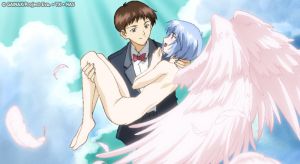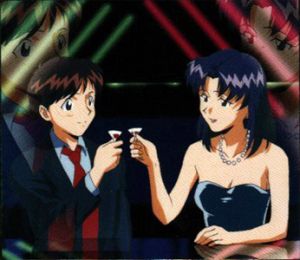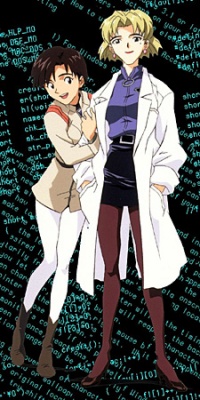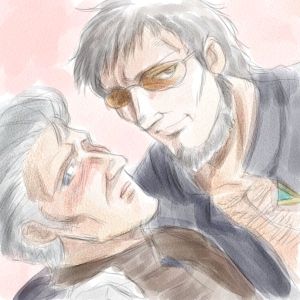Geektionary: Difference between revisions
The wayneiac (talk | contribs) (Rearrange links per Reichu) |
RussianRiz (talk | contribs) m (Tweaked the images to make the page less chaotic to read.) |
||
| (79 intermediate revisions by 12 users not shown) | |||
| Line 1: | Line 1: | ||
{{Archived}} | |||
'''''Note: You will notice that The Geektionary occasionally uses first person references in violation of this site's standards and practices. This is the exception that tests the rule. Don't anyone else do this.''''' | '''''Note: You will notice that The Geektionary occasionally uses first person references in violation of this site's standards and practices. This is the exception that tests the rule. Don't anyone else do this.''''' | ||
'' | '''''<font color=darkblue>Note: The Geektionary is OLD, and much of the information here is a time capsule from the active days of the Eva Commentary project in the mid-2000s. As such, things have changed dramatically since this was written, and much of this has been rendered irrelevant or nonsensical come 2020. It is kept mostly for archival purposes, or as a nostalgic reminder of previous times. Don't take any of this as representative of the current state of the Evangelion franchise or fandom.</font color>''''' | ||
'''''<font color=red>The purpose of The Geektionary is mostly humorous. Any barbs you see aimed at real people shouldn't be taken seriously, and should NOT be used as the basis of personal attacks against them in any manner.</font color>''''' | |||
==Introduction== | |||
Like anything else, geeks have their own unique subculture, and Evangelion geeks are no exception. The aim of the Geektionary is to provide a little guide to the incomprehensible geek-culture saturating the entire commentary (the FGC community in particular). People who actually have lives are bound to ask these kinds of questions: “What the heck do all those acronyms stand for? What is this ReDeath they keep on mentioning, or Thumbnail Theatre, for that matter? And what's all that weird Japanese they keep on throwing in? I speak English, goddamit!” | |||
Some terms, like “AMV” and “shipping”, are hardly specific to NGE geekdom, but we will explain their significance to the fandom nonetheless. For explanations of various other Internet geek memes you might see in use (like the omnipresent “n00b”), I recommend Urban Dictionary and Wikipedia. | |||
{{Template:CompactTOC8|name=Geektionary|side=yes|num=yes|align=left|custom1=Acronym Guide|b=[[#B-C|B-C]]|c=|d=[[#D-E|D-E]]|e=|h=[[#H-K|H-K]]|i=|j=|k=|o=[[#O-P|O-P]]|p=|q=[[#Q-R|Q-R]]|r=|u=[[#U-Z|U-Z]]|v=|w=|x=|y=|z=}} | |||
=A= | |||
==Addition Drama Track== | |||
To save Reichu's phalanges some effort, look [http://www.everything2.com/index.pl?node_id=1041372 here]. Then, go [http://www.evamonkey.com/addition_audio_drama.php here] and download the picsub. There is little more to say. | |||
==ADV== | |||
Formerly a prominent name in the realm of anime localization, which acquired the NGE TV series when the Texas-based company was still young and localized it for western countries*. The English dub they produced remains — as part of the bigger, perpetually futile Dubs vs. Subs debate — an apple of discord within the NGE community (''As of 2020, their dub has received a surprising level of renewed appreciation after the Netflix dub ignited controversy of its own''). Their pre-Platinum releases were not, like many domestic anime releases of that time, up to par with the expectations of today. While the horrendous picture quality was not their fault, the translations used for both the subtitles and the dub obscured, distorted, or outright erased many of NGE's finer points — thus making deeper understanding of an anime that so heavily utilizes subtlety more unobtainable than would a reliable translation. (And the dub, by the very nature of dubs, exacerbated the problem.) Other strikes against ADV include: | |||
*The promotion of misinformation via the descriptions on the video packages and “supplemental” materials included in their releases. | |||
*Their failure to wait for the Japanese video releases of the final TV episodes, resulting in an unnecessarily long wait for the NPC episodes. (But as an unintended “bonus”, this meant that we did get the original TV cuts of these episodes. ::p) | |||
*The utilization of overlays in the Collection volumes. | |||
*Their decision to release Platinum in such close proximity to the long-delayed release of the [[Director's Cut episodes|Director's Cut]] episodes. Getting the pre-Renewal NPC episodes locally is still a boon for completists, but this bad commercial decision — “bad” as in “respectability meter down another point”, not “bad” from the cold and inhuman money-milking POV — was still a peeve for many. | |||
*No need to go on with various other minutiae… Despite the bad timing of Platinum, ADV has largely redeemed themselves with it. See [[Geektionary#Platinum|Platinum]] for more details. | |||
* I'm only certain about the US, UK, and Canada. Not sure about elsewhere, or how releases lacking the ADV label were, or weren't, connected to ADV. Anyone? | |||
==Angel Tower== | |||
[[Image:23 C142 angel-tower genga.jpg|thumb|The Angel Tower]] | |||
The grotesque form that bubbles out of EVA-00's back in episode #23', a conglomeration of Armisael's dead siblings, immediately after Rei's metaphysical interchange with the 16th concludes, and a matter long perplexing fans. Infrequently referenced by its Japanese equivalent, "shito no tou" 使徒の塔. Coined by Reichu. | |||
==Angelic Days== | |||
See [[Geektionary#Love Eva|Love Eva]]. | |||
==Anti-shipping== | |||
See [[Geektionary#Shipping|Shipping]]. | |||
==AWL== | |||
Amanda Winn Lee, the dub voice of Rei and ADR director for the English adaptation of the two movies (and unofficially for parts of the TV series). She has earned a harsh reputation among most of us geeks for a number of reasons — most highlighted by her [[The Geektionary#Commentary of Evil|Commentary of Evil]]. This acronym is particularly useful because, as tv33 put it, “Her true name is too evil to be typed in full.” | |||
==AU == | |||
Alternate Universe. This acronym is certainly nothing new, but in NGE fandom it specifically refers to the infamous sequence from episode #26, wherein we get a frightening glimpse of what NGE might have been like were it a teenage school romance/comedy… without Evas or Nerv, and with a Rei who is Rei in appearance only. A lot of people seem to think that this sequence is the pinnacle of the series, but Reichu thinks that said people are all missing the point. This particular AU was elaborated upon in the video game Girlfriend of Steel 2, but… well, look [[The Geektionary#*GOS2|here]]. | |||
*The [[Geektionary#Live Action Sequence|live action sequence]] that was cut from EoE could also be considered AU. | |||
{{-}} | |||
=B-C= | |||
==BIB == | |||
Big Irony Bomb. I.e., [[FGC:Episode_02_Cut_073|this.]] | |||
==Bridge Bunnies == | |||
"'''Bridge Bunnies'''" is the light-hearted fan-nickname given to the team who works on the "bridge" of [[Nerv]] headquarters; the trio of [[Maya Ibuki]], [[Makoto Hyuga]], and [[Shigeru Aoba]], although the other unnamed operators are also included under this definition. | |||
{{MontageBox | |||
|float = | |||
|columns = 3 | |||
|title = The Bridge Bunnies | |||
|colour = | |||
|image1 = [[Image:OP C040 maya.jpg|thumb|200px|Maya Ibuki]] | |||
|image2 = [[Image:OP C038 hyuga.jpg|thumb|200px|Makota Hyuga]] | |||
|image3 = [[Image:OP C039 aoba.jpg|thumb|200px|Shigeru Aoba]] | |||
|image4 = | |||
|image5 = | |||
|image6 = | |||
|image7 = | |||
|image8 = | |||
|image9 = | |||
|image10 = | |||
|image11 = | |||
|image12 = | |||
|caption = | |||
}} | |||
{{-}} | |||
==Commentary of Evil== | |||
A term, popularized by Dr. Nick, that refers to the notorious commentary track spanning Manga Entertainment's two NGE releases (Death & Rebirth and End of Evangelion), featuring Amanda Winn Lee, Jason C. Lee (her husband and dub voice of Aoba), and Taliesin Jaffe. While the track has some comedic merit, it is good for little else, packed head-to-toe with misinformation and shameless endorsement of the movies' dub (which even NGE dubbies tend to agree is a disappointment!) and the oftentimes horrifying decisions she made producing it (including [http://www.evamonkey.com/gunshot.mov this one]). Jaffe gets a break because he at least attempted to present some worthwhile material, even if he wasn't 100% on track either (“Samhel”?). For something meant to accompany a very complicated and serious work of art, their commentary is offensively inadequate. | |||
<font color=red>'''While we may make a mockery of the commentary and the lack of Evangelion knowledge displayed therein, it is important to point out in this new internet "age of rage" that we DO NOT condone personal attacks against Amanda Winn Lee or anybody else involved in the production of the commentary or the ADV English dub. We condemn any personal attacks or hatred directed toward any former ADV staff as utterly abhorrent.'''</font color> | |||
=D-E= | |||
===Doujinshi=== | |||
Often shortened to ''Doujin'' (同人), are self published japanese works such as artbooks, manga, or novels. Doujinshi are often created by amatuers and on some occasions professionals self-publish works as side projects. Many doujinshi artists work in groups called ''circles'' and many sell their works at a bi-annual event in Tokyo called ''Comiket''. Many doujinshi works are spin-offs or parodies of existing official anime and manga, and are often adult oriented (pornographic). | |||
==ED== | |||
Ending. I.e., the ending sequence of an anime (you know, the one that has credits and stuff). Genuine anime industry shorthand, BTW. | |||
==EGK== | |||
[[Image:Eva02designeoe.gif|thumb|left|Evil Gekijouban Kyoko]] | |||
Evil Gekijouban* Kyoko(-sama). EGK — which probably resembles a gagging noise on purpose — is the EVA-02 who resulted from a most unfair design overhaul that was somehow deemed necessary for EoE. At best, gekijouban EVA-02 has a slightly modified head design, shrunken pylons, a slight slouch, and the body proportions of a harpy. At worst, the animator of a large number of cuts for the UBF turned her into this: :screams in horror: | |||
[[Image:Hondaubf.jpg|thumb|Really Evil Gekijouban Kyoko]] | |||
The latter is so completely abominable, it merits a new acronym: REGK (REALLY Evil Gekijouban Kyoko). What's really strange is that [[Takeshi Honda]] did the cited illustration of REGK, along with an illo for the Reprise of Evangelion CD where EVA-02 has the same frelled-up head design. Is he the one responsible for those dodgily-drawn cuts in #25′?!? | |||
* For those not in the know, gekijouban means “theatrical edition” and is generally used in reference to, well, a theatrical adaptation of something that wasn't theatrical to start with — sort of like saying “<title>: The Movie” or “<title>: The Motion Picture”. With regards to NGE, it refers to both D&R and EoE — but, here, we specifically mean EoE, since it's, you know, the NGE movie. | |||
A short comparison between the original EVA-02 featured in the series and the EGK is available in [http://forum.evageeks.org/viewtopic.php?t=5814&start=42 this forum post] (warning: possible Rebuild spoilers!). | |||
==EMK== | |||
[[Image:Emk.gif|thumb|left|''Evil Manga Kaworu'']] | |||
Evil Manga Kaworu. Sadamoto's Kaworu is a stalker who kills kittens, and the gentle, elegant Kaworu of the anime isn't; ergo, the manga Kaworu is Evil. Well, it's a popular fan sentiment, anyway (and requires an acronym for easy reference, which was provided by Magami No ER). The "kitten-killing" part inevitably inspired some unknown individual to weave a spin-off on a certain [http://en.wikipedia.org/wiki/Every_time_you_masturbate%E2%80%A6_God_kills_a_kitten infamous meme] involving kittens, Domo-kun, and God, which is: "Every time you masturbate, Kaworu kills a kitten". Although some continue to extract endless entertainment from Kaworu's autosex-inspired felinocide, others wish it would just go away. However, Evil Manga Kaworu has reportedly said, "This meme is destined to live forever, even though it may result in the destruction of the human race." While this comment seems contradictory at first -- as the continued existence of the joke results in the death of kittens and not humans -- there is perhaps some truth to it. | |||
==EoTV== | |||
End of TV. Specifically, this refers to episodes #25 and #26 as the counterpart of EoE episodes #25′ and #26′. An exceptionally useful acronym. | |||
==EU== | |||
Expanded Universe. This idea is quite familiar to the geek: The universe of a franchise is “fleshed out” with apocryphal media (books, video games, collectible card games, etc.) that satisfies the fans' collective lust for MORE!!!, while having the nice bonus of putting lots of dough into the pockets of a select few. NGE is no exception, of course, and its EU includes such wondrous [/sarcasm] things as the original Sega Saturn, Second Impression, and Girlfriend of Steel video/computer games and the [[Neon Genesis Evangelion RPG: The Nerv White Paper|Evangelion RPG]]. These items aren't canonical by any means, but they provide new characters like Mana Kirishima and Mayumi Yamagishi (i.e., alternate side dishes for fapboys), various new Angels, and kickass mecha like the [[Geektionary#T-Riden-T Land Cruiser|<s>Toyota</s> T-RIDEN-T Land Cruiser.]] | |||
=="Every time you masturbate, Kaworu kills a kitten."== | |||
See [[Geektionary#EMK|EMK]]. | |||
{{-}} | |||
=F= | |||
==Fan Art== | |||
Often referring to unofficial artwork by amatuer artists using existing media as the subject matter. | |||
==Fanfiction== | |||
See [[The Geektionary#Geek|Fan-Geek]]. | |||
Also see [http://www.fanfiction.net/anime/evangelion Evangelion section on FFN] | |||
Evangelion ficdom is notorious for its high opinion of itself. It exhalts it's awesomeness and superiority over all other lowly forms of fanfiction like Naruto, or DragonBall Z, or even the Harry Potter section. While this may once have been true, one look at the above link will quickly prove that this is nothing but bollocks. It also maintains the unique ability to take itself insanely seriously... to the point where people forget it's supposed to be one huge laugh. | |||
Evangelion fanfiction comes in several flavours: | |||
:WAFF (Warm And Fuzzy Feeling): | |||
::Everyone lives happily ever after. Regardless of established characterisation, universe rules or plain good taste. Usually involves [[Geektionary#Shipping|Pairings]]...which are even worse. | |||
:Darkfic: | |||
::See above... only everybody dies in the end. Horribly. Including Pen-Pen. Usually used by authors to beat out their frustrations from their own lives on harmless fictional characters. | |||
:Post Third Impact: | |||
::For those for whom the end just wasn't good enough. Usually either a WAFF or a Darkfic. Usually lacks the depth of the original series. | |||
:Lemons | |||
::Tongues, Toys and Tentacles.... Avoid at all costs unless you want to know what Asuka felt like beneath Arael's spotlight of doom. | |||
:Self Insert: | |||
::For those for whom real life just isn't good enough. The lowest of the low. Those who hate themselves so much, they adopt their own idealised persona, bed everything with a pulse in the ::universe, and frack things up faster than the JSSDF on Impact-Day. Not to mention the fact that a good deal of them seem to be better suited to fictionmania... | |||
==Fan-Geek== | |||
See [[The Geektionary#Geek|Geek]]. | |||
==Fan Service== | |||
Fan Service is when the production team of a series inserts material that does nothing to move the plot along but just exists to give the fans a thrill. | |||
When they hear the term "fan service", most people tend to think of sex and nudity: a typical example of such ''ecchi'' fan service in NGE would include Misato leaning forward at the dinner table in [[Episode 02]], giving Shinji, and the audience, a good look at her cleavage, and the subsequent shot of her backside in tight shorts. However, it is important to note that not all nudity is considered fan service. Rei's nudity in Episode 05 and Asuka's exposing her breasts to Kaji in Episode 22' give the audience important information about their characters, and should thus probably not be considered gratuitous. | |||
The term fan service is also used to describe various other things including gratuitous action and explosions. Misato's Alpine A310, references to old science fiction movies and even the cans of Yebichu beer classify as "fan service". | |||
[[Image:Daicon IV bounce.jpg|thumb|left|Milk tank physics - Gainax's claim to fame]] | |||
Gainax is semi-notorious for the adding the "Gainax bounce" (first introduced in the Daicon IV opening animation) into anime series they have created, in which female characters' boobs will jiggle to an unusually large degree when they move. | |||
While bounce-wise Evangelion is rather restrained for a Gainax series (especially in comparison to some of the studio's later works like ''He Is My Master''), there are still plenty of suggestive scenes to go around, and in early episodes Misato actually previews next week's upcoming episode by promising "...and more fan service!" Promises of fan service have become a minor Gainax tradition and they've been recycled in episode previews in ''Mahoromatic'' and ''Magical Shopping Arcade Abenobashi''. | |||
You might also want to read Reichu's essay-post in the forums on [http://evageeks.org/forum/viewtopic.php?p=18774#18774 excessive sexual objectification in NGE merchandise] (another topic that invariably leads to naked Evas). | |||
==Fanwanking== | |||
A term, sometimes used in a deragatory intent, used to describe the act that fans of a work sometimes do to fill plotholes (or just missing links within the narrative) within the work, often employing specific facets or elements of the work while adding new ones. Because details or plotpoints are often added into the attempt to fill in plotholes, these explanations are not considered "official" or "canonical". While some fanwanking may be rampant and done purely for fun, there are some fanwanks which are consistent enough with the original work and fills in the plotholes so nicely that other fans will jump on the wagon. Although these are sometimes referred to as "Fan Theories", they are still contested to this day and should not be considered canonical. | |||
Among some of the popular subjects in Evangelion to fanwank are | |||
* [http://www.evageeks.org/forum/viewtopic.php?t=3760 What Gendo said to Ritsuko in EoE] | |||
* [http://www.evageeks.org/forum/viewtopic.php?t=3793 Details of Second Impact] | |||
* [http://www.evageeks.org/forum/viewtopic.php?t=2859 Details of Third Impact] | |||
* [http://www.evageeks.org/forum/viewtopic.php?t=3785 Evangelion Unit-00's Soul] | |||
* [http://www.evageeks.org/forum/viewtopic.php?t=2095 Kaworu in Nerv's Terminal Dogma, mistaking Lilith for Adam] | |||
* [http://www.evageeks.org/forum/viewtopic.php?t=3765 The 15 Seele Monoliths in Episode 24'] | |||
==Fuzzy Logic== | |||
This pun on the algebraic term is an endearing reference to our old friend Fuzzy Chickens (see [[Geektionary#Troll|Troll]]), whose thought processes were oftentimes frustratingly — and famously — unfathomable: in other words, “fuzzy” ([http://dictionary.reference.com/search?q=fuzzy definition 4]). An example of "Fuzzy Logic": Fuzzy claimed to disbelieve that Rei had Lilith's soul. When it was pointed out to him that Kaworu said to Rei, "We have both taken the Lilim's form on this planet," Fuzzy replied, "So what? So has everyone else."!!! Fuzzy also once opined that the "real reason" that Rei slaps Shinji in [[Episode 05]] is because she was being deliberately sexually provocative in the infamous "glasses" scene and had been doing a slow burn all during their trip to HQ because he didn't do her on the spot. | |||
=G= | |||
[ | ==Geek== | ||
Here this term is used in an entirely neutral way, implying no more than (to borrow from [http://en.wikipedia.org/wiki/Geek Wikipedia]) "a person with a devotion to something in a way that places him or her outside the mainstream. This could be due to the intensity, depth, or subject of their interest." A "fan-geek" is simply a gender neutral variation upon "fanboy" or "fangirl" -- but, again, has only neutral connotations at FGC. | |||
[[ | ==Gender== | ||
This entry is kinda long, so I'm giving it its [[Gender|own page]]. (Warning: Said page is, like some other things on a this site, a rather out-dated relic which will be replaced with much better things soon enough.) | |||
= | ==GNG== | ||
Giant Naked Gendo. A theoretic entity that would have appeared if Gendo's plan for Instrumentality had succeeded. A counterpart to Giant Naked Rei and Giant Naked Kaworu. | |||
==GNK== | |||
Giant Naked Kaworu. The counterpart of Giant Naked Rei: the gargantuan, nude, and sexually androgynous Kaworu that briefly appears in EoE to calm poor Shinji's overtaxed senses (and do other mysterious things). While this acronym seems blindingly obvious in retrospect, HeWhoPostsStuff was the first one to put it to use. | |||
==GNR== | |||
Giant Naked Rei. One of the most beloved acronyms, and also one of the most useful. This refers to the giant Rei from End of Evangelion, produced by the conglomeration of Rei 3, Adam, and Lilith (eventually sucking up the Tree of Life -- EVA-01 and the Spear of Longinus -- for good measure). Sadly, no one knows where this acronym originally came from. | |||
==GOS== | |||
[[Image:Gosstayaway.jpg|thumb|''"Stay away from my man, bitch, or I'll kick your sorry ass into next year!"'']] | |||
[[Girlfriend of Steel|Girlfriend of Steel*]] (from Koutetsu no Girlfriend 鋼鉄のガールフレンド). An EU side story/dating sim released for the Sega Saturn and PC back in 1998, placed at around the end of the Action Arc (after #13, perhaps?). It is lent some “authenticity” by the fact that actual anime staff did work on it: Sadamoto and Yamashita contributed new character and mecha designs, the seiyuu reprised their character roles, it was illustrated by animators from the show, and so on. However, “playing” it is akin to sitting through a couple-hour-long fan-fiction presented in Flash format — albeit a Flash with almost no actual animation to speak of, the game instead resorting to cut-out characters moving around (think motion tweens) on painted backgrounds, if they move at all. Likewise, there is virtually no interactivity at all, but, apparently, sitting through these “A/V novels” is par for the course among Japanese gamers. | |||
[[Image:Gosgetit.jpg|thumb|left|''"Yeah! Come get some! Bring it! BRING IT!"'']] | |||
Suffering through GOS should be considered a rite of passage for NGE geeks, so I'll keep the synopsis short and spoiler-free. Essentially, GOS revolves around a new character named Mana Kirishima (who continues the NGE tradition and has a surname taken from a WW2 naval vessel), who shows up as a transfer student in Class 2-A. She's a nauseatingly cute, genki schoolgirl (voiced by Megumi Hayashibara) who immediately begins hitting on Shinji — since, you know, Shinji is 100% babe magnet and all. But, oh, what a dark secret she holds! Could it possibly have anything to do with that giant robot (the [[Geektionary#T-RIDEN-T Land Cruiser|T-RIDEN-T Land Cruiser)]] that's prowling around Tokyo-3 at night? Or that hospitalized kid who drove his mecha off a waterfall? Or the really weird way Shinji's superiors at Nerv are acting? This couldn't be some kind of conspiracy, could it?!? Further questions abound! Will Asuka succeed in keeping her Baka-Shinji away from that Mana tramp? More importantly, will Rei actually get more than three lines of dialogue?? Get ahold of the fan-translated PC version if you just have to know! | |||
The game has also spawned a beefed-up PS2 version released in March 2006, with the complimentary titles "Girlfriend of Steel Special Edition" (Koutetsu no Girlfriend Tokubetsuhen) and "Iron Maiden: Jesu, Joy of Man's Desiring". Apparently it has new scenarios, voices, animations, and even a new mecha designed by Yamashita-san (thanks for the tidbits, AA), but not much else is known right now. | |||
* The official English title is actually “Iron Maiden”, but very few Westerners actually call it that, presumably because of the band by the same name. Shame — considering what an “Iron Maiden” is, the title is all-too-appropriate… (The title of a certain [http://iron-maiden-lyrics.wonderlyrics.com/Can-I-Play-With-Madness.html Iron Maiden song] is also strangely applicable.) | |||
==*GOS2== | |||
Girlfriend of Steel 2 (as it is called among Westerners, even though the official English title is Iron Maiden 2nd). A sequel to GOS in spirit only: The only things this game really has in common with its predecessor are the dating sim premise (with much more dating this time around) and the basic gameplay engine. To avoid unnecessary work on my part, just check out my Walkthrough, which has a Q'n'A section at the beginning. | |||
See also Love Eva. | |||
==-gouki== | |||
-号機 The Japanese way of saying “Unit # <so and so>”, usually in reference to pieces of machinery and other artificial constructs (like the Pokémon Porygon). This suffix is used in conjunction with the Evas' individual designations in spoken Japanese: So, even though a certain purple-clad Evangelion might have “EVA 01” written in big green letters on her arms and be referred to as “EVA-01” on computer monitors throughout the show, everyone speaking Japanese will instead call her “Shogouki” (with the sho meaning “first” and not “one”, for some incomprehensible reason; it's a -gouki tradition not limited to NGE). Of course, ADV/Manga's localizations do NOT use the “EVA-##” setup presented as the English equivalent for “-gouki” and instead just do a literal translation, resulting in “Unit” this and “Unit” that. | |||
Due to some strange personality quirk, I hate to see Evas being called “units”. (It's probably Butt-head's fault.) Then… in translation, the tradition of substituting “#-gouki” with “EVA-##” poses certain problems when the “#-gouki” is preceded by “Eva” or “Evangelion”. In those instances, you will see in the FGC scripts that I do, in fact, resort to that horrible “U” word after all. Thus, “Eva Shogouki” becomes "Eva Unit 01". | |||
To the point, despite the fact that Shogouki, Nigouki, etc., are terms that essentially treat the Evas like pieces like machinery, I got into the habit of using them on forums because (A) they sound cool when pronounced correctly (hint: ou is a long “o”, like in … grope), and (B) having them as alternatives to the usual monikers spices up NGE conversation. As with many things, this habit eventually began to catch on, and -gouki mysteriously started showing up in other people's posts… Anyway, here's the run-down so you can use these appellations yourself. | |||
{| class="wikitable" border="1" | |||
|- | |||
! Japanese (kanji) | |||
! Japanese (romaji) | |||
! English Equivalent | |||
|- | |||
| 零号機 | |||
| Zerogouki | |||
| EVA-00 (Unit 00) | |||
|- | |||
| 初号機 | |||
| Shogouki | |||
| EVA-01 (Unit 01) | |||
|- | |||
| 弐号機 | |||
| Nigouki | |||
| EVA-02 (Unit 02) | |||
|- | |||
| 3号機 (or 参号機) | |||
| Sangouki | |||
| EVA-03 (Unit 03) | |||
|- | |||
| 4号機 | |||
| Yongouki | |||
| EVA-04 (Unit 04) | |||
|- | |||
| 5号機 (or 伍号機)、6号機、7号機、8号機、9号機、10号機、11号機、12号機、13号機 | |||
| Gogouki, Rokugouki, Nanagouki, Hachigouki, Kyuugouki, Juugouki, Juuichigouki, Juunigouki, Juusangouki | |||
| EVA-05, etc. (Unit 05, etc.) | |||
|} | |||
Ultimately, these monikers are okay, because one can simply change the kanji and turn them into names without any mechanical connotations whatsoever! Take -gouki for example… If you form it with the kanji 強鬼, it means “strong oni”! (Or something like that. It's apparently a real kanji compound.) </lame justifier> | |||
==Greenfield, Matt== | |||
The president of the ADV Empire, husband of Tiffany Grant (VA of dub-Asuka), and a figure of some notoriety amongst many NGE geeks — primarily owing to his tendency to talk pretentiously about aspects of the show he knows very little about. | |||
==GSF== | |||
Archaic. Genetically Similar Facsimile. Created by tv33 as a replacement for the term “clone” in reference to the relationship between the Evas and Adam, due to my consistent bitching about how the Evas cannot be “clones” of anything considering the physical variation they exhibit amongst themselves. GSF ends up being an oxymoron, though, since ”facsimile” is essentially synonymous with “clone” — which sorta defeats the ”genetically similar [but not quite the same]” part. | |||
''Entries penned (or simply assembled) by Reichu unless otherwise noted. Harsh statements about certain individuals are only expressions of geeky displeasure with their NGE-related flubs, not assaults on their actual persons. There's an important distinction.'' | |||
{{-}} | |||
=H-K= | |||
==Harpy== | |||
[[Image:Harpy.jpg|thumb|left|A harpy from EOE]] | |||
One of the Mass Production Model Evangelions. A [http://en.wikipedia.org/wiki/Harpy harpy], in case you weren't aware, is a creature from Greek mythology — part woman, part predatory bird, and generally unpleasant. (Well, that definition of “harpy” might be a perversion of the original intent, but … whatever.) The name is delightfully appropriate for NGE's “Eva Series”, and so it has stuck. Interestingly, the idea to call the MP Evas “harpies” appears to have emerged multiple times independently, as many great ideas do. | |||
==HIP== | |||
Human Instrumentality Project. The actual Japanese term is Jinrui Hokan Keikaku, which means something like “Human Complementation Project”. However, Anno decided to confuse everybody and use this opportunity to sneak in another gratuitous sci-fi reference [will elaborate more later], so the official English rendition of J.H.K. is “Human Instrumentality Project”, even though “complementation” and “instrumentality” mean completely different things. Oh, well. | |||
==Iron Maiden== | |||
See [[The Geektionary#GOS|GOS]]. | |||
==Kanji== | |||
''Kanji'' are the part of the Japanese writing system that have been borrowed directly from the Chinese writing system, as opposed to Katakana and Hiragana. They are ideograms and are not phonetic, therefore requiring the memorization of the ideograms in order to understand the meaning. Although most of the borrowed words retain the same or similar meanings as they did in Chinese, some words have different meanings from the Chinese counterpart. | |||
==KFR== | |||
[[Image:KFR.jpg|thumb|Kentucky Fried Rei]] | |||
[[Image:Kfrsb.jpg|thumb|left|KFR Storyboard]] | |||
Kentucky Fried Rei. The corpse of Rei 2 that was (against all probability and logic) recovered by Ritsuko-tachi after Tokyo-3 was vaporized. Created on a whim (by Reichu — who else? @_@) for entirely silly purposes, in vague reference to Shin-seiki's assertion, “I think the gruesome truth is [Rei 2] was roasted alive in the plug.” | |||
==Kyoko-sama== | |||
In the same vein as Yui-sama — a more “PC” way of referring to EVA-02 (by the name of her soul, rather than by a number), while acknowledging (in typical Reichu fashion…) that becoming an Evangelion has made her great and worthy of the -sama suffix. Extremely silly, but eventually, like “Yui-sama”, other people started using it without any prompting from me… | |||
{{-}} | |||
=L= | |||
==LCL== | |||
[[Image:Reichu-lilith-tampons.jpg|thumb|left|Ewwww! Grossssss!]] | |||
Who the hell knows? [[Red Cross Book|The EoE Theatrical Program]] actually bothered to tell us that it isn't “Link Connect(ed/ion) Liquid”. Strangely, it doesn't say what it actually DOES stand for. Bastards. Shin-seiki has suggested that it stands for “Lilith's Creation Liquid”, which is a distinct possibility. Given its source, an alternative expansion for the “C” has also been proposed by AchtungAffen… | |||
==LAEM== | |||
Live Action Evangelion Movie. This is a project that ADV started around 2003, to the horror, anxiety, or, perhaps less frequently, anticipation of NGE fan-geeks everywhere. With nothing but a script and a handful of concept art by [http://www.wetadigital.com/ WETA's] artists, they promoted the project shamelessly, even including featurettes on their "Directors' Cut" DVDs. Many futile threads emerged debating over whether or not the movie would suck, although things settled down somewhat when, two years later, absolutely no news had emerged. This most impeccable acronym began when Dr. Nick mused, “Hmm, LAEM… I like that acronym. It resembles the word LAME delightfully well.” No more needs to be said, really. | |||
==Live Action Sequence== | |||
Remember that weird EoE trailer at the very start of the movie, with all the live action shots that were, well, nowhere in the actual program? Aren't you just dying with curiosity? Go here, NOW. ^_^ | |||
==LnY== | |||
Longinus no yari (= Spear of Longinus). A proposed replacement for LoL, but nobody really seems to use it. | |||
==LoL== | |||
[[Image:M26 C031 a big.jpg|thumb|''"The red pitchfork of doom"'']] | |||
Lance of Longinus. This term* was used without a second thought until we learned that “Spear of Longinus” is the official English rendition of Longinus no yari (as proven by a computer screen in #25′) . That “spear” is used is not terribly surprising, considering the very weapon for which the Red Pitchfork of Doom was named is commonly referred to as the “Spear of Destiny”; and, for my part, I've never heard of Jahshua Ha Mashiyach (or Jesus Christ, if you've never heard of the other guy) being poked with a “lance”. Debates have ensued about exactly which type of weapon (spear or lance) the thing in NGE really is, with conclusions being reached on both ends. But, let's face it… In Japanese, “spear” and “lance” are the same word (yari). In Latin — Longinus was a Roman soldier, after all — lancea can mean both “spear” and “lance”. Heck, the [http://bible.crosswalk.com/Lexicons/Greek/grk.cgi?number=3057&version=kjv Greek word] (logche) that references the thing in John 19:34 can apparently mean both. EoE says it's a “spear”. So call it a goddamn spear! Or, alternatively, we could make everyone happy and call it the "Bident of Longinus". | |||
Since the acronym SoL was already used, LnY was proposed as a replacement. This doesn't seem to have quite caught on, though, since, even knowing that calling it a “Lance” is incorrect, a lot of people just can't seem to stop doing it, presumably because (A) “Lance of Longinus” rolls off the tongue, and (B) the acronym is funny. (lol!!!11) | |||
I suspect this silly argument will find its way into an appendix eventually. Better than hogging space here. | |||
* Mr. Tines notes, “‘Lance’ was drawn from Arthurian usage, if nothing else. The usual place (outside NGE) to find mentions of the weapon is in the context of the Dolorous Stroke inflicted on King Pellam by Sir Balin; and even though Malory describes the weapon as ‘that was the same spear that Longius [sic] smote our Lord to the heart’, the weapon is more often referred to as a Lance (given the association with knights in armour).” | |||
==Love Eva== | |||
A nickname for the [[Girlfriend of Steel 2 (manga)| “Girlfriend of Steel 2” manga,]] in homage to Ken Akamatsu's Love Hina. For the English adaptation published in ADV's Newtype US, it was retitled Angelic Days. | |||
==LTP== | |||
see [[Literal Translation Project]] | |||
=M= | |||
==Mangle Entertainment== | |||
Used in reference to [http://www.manga.com/ Manga Entertainment], which is somewhat notorious for botching its anime releases — not to mention sitting on major licenses for years. :cough:Gunbuster:cough: | |||
==McCoy, Sean== | |||
“If Matt Greenfield is Batman, Sean McCoy is the Boy Wonder.” —Dr Nick. For actual information, see [[Geektionary #Platinum Special Features|Platinum Special Features]]. | |||
==MP== | |||
Mass Production (Model Evangelion) = Eva Series (or harpy). | |||
==Mythology of Evangelion== | |||
See [[Geektionary #Platinum Special Features|Platinum Special Features]]. | |||
''Entries penned (or simply assembled) by Reichu unless otherwise noted. Harsh statements about certain individuals are only expressions of geeky displeasure with their NGE-related flubs, not assaults on their actual persons. There's an important distinction.'' | |||
=N= | |||
==Nigouki== | |||
See [[Geektionary#-gouki|-gouki]]. | |||
==Nissan== | |||
[[Image:Reichunissan.jpg|thumb|''Go on, touch it! You know you want to.'']] | |||
You know the world is about to end when even the great Hideaki Anno has sold his soul to appear in a car commercial. What's even richer than that is this particular advertising campaign's slogan: [http://www.conbinibento.com/archives/2005/04/18/touch-my-what/ “Touch your Nissan”]. Hmmm… Sounds like another “euphemism”, if you know what I mean… :wink wink nudge nudge: | |||
{{-}} | |||
==NPC== | |||
{{relocate}} | |||
[[Image:Geektionarynpc.gif|thumb|left|An NPC medley]] | |||
New Production Cut. While looking through my Groundwork of Evangelion books, I stumbled across the term shinsaku KATTO 新作カット (literally, “new production cut”) used in reference to the material added to the Video & LD versions of episodes #21 ~ #24. While the updated versions of these episodes are officially referred to as the “Video & LD” versions, this terminology is very confusing to poor Westerners who have been acquainted with NGE by way of ADV: Rather than having their releases correspond directly to those of the Japanese, ADV instead gave us the televised versions of episodes #21 and up with their initial video cassette and DVD releases of Evangelion. (This is because the Japanese video releases were delayed as a result of these episodes being reworked, and ADV wasn't of the mind to wait.) When ADV finally did release the Video & LD versions of those four episodes domestically, they were christened the [[Director's Cut episodes|Director's Cut]] episodes — although this terminology is also confusing, since it leads some to believe that material was CUT from the original release, whereas, in actuality, all of the added and modified material was produced specifically FOR the video release. “New Production Cut” is thus more useful among Westerners than “Video & LD Version” and less ambiguous than “Directors' Cut” — so I zealously promoted the usage of the term. | |||
As it would go, though, later findings led me to believe that shinsaku KATTO referred NOT to episodes #21′ through #24′ in their entirety, but only to the cuts produced anew for them. Ergo, any additional or modified cut (not in the original OA version) would be a “newly-produced cut”. The term apparently also refers to the cuts produced exclusively for DEATH. However, since my efforts have already acid-etched “NPC” into the brains of my cohorts, it has become a bit too late to revoke the acronym on account of what is essentially a technicality. It remains useful, so it might as well be used. | |||
==Nucleola== | |||
{{relocate}} | |||
(Pl.: nucleolae) EVA-01 possesses two (later, four) of what look like miniature cores around the big one, but what exactly these things are is never elaborated upon. | |||
[[Image:Nucleolae.jpg|thumb|The "Small Cores"]] | |||
[[Image:Eva01heavy-damage.gif|thumb|left|Production sketch showing the small cores]] | |||
{{-}} | |||
Production drawings refer to these only as chiisana na koukyuu, or "small light-spheres/cores" (koukyuu is used interchangeably with KOA , "core"). Since "small light-spheres/cores" is rather ungainly, Reichu fabricated the term "nucleola" (the feminine diminutive form of Latin nucleus, "kernel" or "core") as a general-purpose substitute. ...then again, nobody really uses it. | |||
=O-P= | |||
==OP== | |||
Opening. I.e., the opening sequence of an anime, or whatever. Like ED, this is genuine anime industry shorthand. | |||
==Pierre== | |||
See [[Geektionary#Seele Dudes|Seele Dudes]]. | |||
{{-}} | |||
==Platinum== | |||
The domestic release of Renewal, minus the movies (Death and EoE) owing to the fact that [[Geektionary#Mangle Entertainment|Manga]] is sitting on the license (and apparently lacks the sense to obtain and localize the remastered movies). | |||
The presentation is minimally altered from the original Japanese release, down to including translated versions of the booklets included with the individually-released Renewal volumes (although the actual content has been distributed in a different manner). Titles are soft rather than permanently imposed onto the picture. And, yippity skippity!, the subtitle translation has been finely tweaked, 95% of the time for the better, rendering these scripts the best ones currently available for the TV series. There are some complaints, such as the absence of any of the Renewal DVD Box-Set's extras save for the animatics included on the bonus disc, along with the suckage of all other included extras. Additionally, the image is not as crisp as Renewal's (but, bizarrely, Platinum gives us MORE of the picture), the DVD menus do not undergo the same progressive change from first disc to last (i.e., they retain the same look throughout), the scrolling notes from the DVDs were not translated for inclusion, and so on. I guess we can live, though… | |||
{{-}} | |||
==Platinum Special Features== | |||
With ADV's domestic release of the remastered TV series, they attempted to out-do prior efforts (e.g., the [[The Geektionary#Commentary of Evil|Commentary of Evil]]) with their own substandard “bonus” features. This included, of course, commentary on select episodes featuring Matt Greenfield (Head honcho of ADV) and the various dub actors who worked on NGE. The initial commentaries were mostly useless — focusing on localization, dubbing, and western fandom — although this could be considered a blessing in disguise, since, by not touching the meat of NGE, they didn't get to prove how utterly little they actually knew about the show. Too bad it didn't last. Soon enough, Greenfield dug up an NGE fan who he felt would add some actual insight on the show to the special features. | |||
And, thus, the name of Sean McCoy began its descent into infamy. None of us had even heard of the guy. Seems he used to prowl Usenet in the late 90's, spreading some rather … interesting theories, notably the one about how Shinji and Asuka had sex in EoE, and Asuka's final words (“Kimochi warui”) were in direct reference to morning sickness. What ended up on the DVDs wasn't any better. The commentary tracks featuring him are bad enough, but the real offender is the two-part special feature entitled [https://www.youtube.com/watch?v=FdadTN2rYxw The Mythology of Eva], wherein Greenfield and McCoy join forces to conjure misconceptions far more potent than either could achieve alone. | |||
'''It bears repeating that while we make fun of McCoy and Greenfield for their demonstrated lack of Evangelion knowledge here, our mockery extends no further than our frustration as fans. We absolutely condemn any personal attacks or hatred directed against either of them in any form.''' | |||
==Pre-3I Instrumentality (P3II)== | |||
This is a term coined by Shin-seiki to refer to the weird sequence in #26′ that involves a mind meld between Shinji, Asuka, Misato, Rei, and Ritsuko — beginning with the "sandbox" scene and ending with Shinji choking Asuka in the kitchen — just before the consequent Third Impact and 'full-fledged' Instrumentality occur. There are those who claim that it was 'all in Shinji's head', although this idea is easy to rip apart due to its many holes. | |||
=Q-R= | |||
==Quantum Magic== | |||
[[Image:01 C022 Rei III girl in street.jpg|thumb|left|Two places at once? She should be in the hospital.]] | |||
A term coined by Reichu as a short-hand reference to an idea I proposed as a possible explanation of certain phenomena in NGE (for the most part associated with Rei) which seem to violate the ordinary constraints of time and space. Notable examples include the apparent simultaneous existence of Rei's soul in Rei 2 and Zerogouki, and the temporal paradox of the Rei apparitions that appear before Misato and Ritsuko in #25′, even though Rei doesn't return to Lilith until #26′. There are various references to sub-atomic physics and quantum mechanics throughout the series: for example, the Dirac Sea; the references to quarks, etc., among the graffiti in Rei's birthplace in Terminal Dogma, | |||
[[Image:Gendosoffice.jpg|thumb|Cyclotron image on Gendo's floor]] | |||
and the image on the floor in Gendo's office, which appears to depict the tracks of high-energy atomic collisions in a cyclotron. In light of these, it has occurred to me that if one posits the notion that souls in NGE function in a manner analogous to some of the counter-intuitive parameters of behavior of sub-atomic particles — e.g., that a single electron may, in certain circumstances, be said to exist in two places at once — that quantum mechanics famously entails, some sense could be made of these soul-related paradoxes. ~Shin-seiki | |||
==RCB== | |||
Red Cross Book. This is the typical gaijin way of referring to the untitled End of Evangelion [[Geektionary#Theatrical Program Books|theatrical program book]]. However, those of us who want to be cool and hip (or possibly just pedantic) go to the trouble of actually writing out "End of Evangelion <insert description of choice>". | |||
==REGK== | |||
See [[The Geektionary#EGK|EGK]]. | |||
==Reiquarium== | |||
The LCL-filled tank inside the Dummy Plug Plant containing Gendo's backup stock of Rei clone bodies, the number of whom changes depending on which version of the scene you happen to be viewing. And, to make a portmanteau out of a portmanteau: The Shinjiquarium is a bizarre variation upon one of the Reiquarium shots (the clones lifting up their heads in unison) occuring in EoE, wherein the Rei faces morph into Shinji faces -- but their bodies remain the same! (We already knew that Shinji Likes Boobies™, but this is ridiculous...!!) | |||
==RIAO== | |||
[[Image:Gos2-rei-face.gif|thumb|The many faces of Rei]] | |||
Rei in Appearance Only. This primarily refers to the much-beloved Rei of episode #26 (and expanded upon in [[The Geektionary#*GOS2|GOS2]]), who looks like Rei and sounds like [[Megumi Hayashibara]], but has, in fact, about as much in common with Rei as Cthulhu has with a Care Bear. This Rei is a hyperactive, genki schoolgirl, a far cry from the quiet, heavily introverted Rei with whom we are more familiar. Some people (many of whom claim to be Rei fans) say that they like RIAO because she represents what Rei would be like if she had grown up under more "ordinary" circumstances. While the portraits of the other characters in the "possible world" sequence of #26 are plausible, Rei is, on a very fundamental level, incapable of being AU Rei. For one thing, her basic personality is against it… But this ultimately becomes a nature vs. nurture argument that is best discussed in full elsewhere (and certainly will be further on down the road). | |||
RIAO may also refer to the various OOC (out-of-character) incarnations of Rei that appear… well… bloody everywhere (like in 90% of her merchandise)! | |||
==RNR== | |||
Regular Naked Rei. That is, a naked Rei that is NOT giant. I invented this in a thread where I was attempting to calculate the total height of GNR by using the Black Moon and EVA-01 for scale, imposing them on an image of normal-sized Rei because a head-to-toe image of GNR does not exist. RNR here became useful as a means of distinguishing Regular Naked Rei from Giant Naked Rei. Absurd, but for some reason it caught on… (Haven't heard it used recently, though.) | |||
==Rubber Science== | |||
Including the sub-discipline “rubber physics”, this is [http://www.sfwa.org/writing/glossary.html defined] as “an explanation which, although probably false according to what we know of the universe, sounds technical and convincing”. Sound familiar? NGE has sci-fi elements, even though most of these are pretty rubbery. Then, hard science isn't really the point: The coolness factor comes first, and then the show only needs to make itself at least seem credible enough for suspension of disbelief to kick in. (Although sometimes this results in a misuse of scientific concepts and terminology on par with the self-servicing butchery of Judæo-Christian tradition… but who cares?) | |||
==Ryousanki== | |||
[[Image:Geektionary-ryousanki.jpg|left|120px]] | |||
量産機 Literally meaning “Mass Production (Model) Unit”, this is a cool-sounding Japanese alternative (in the [[The Geektionary#-gouki|-gouki]] vein) to the usual terminology. Japanese materials commonly refer to the Mass Production Evas (see also [[Geektionary#Harpy|harpy]]) by the rather vague “Eva Series”, which is sort of unpractical for two reasons: (A) “Eva Series” is misleading, since the term technically encompasses all Evas, not just the harpies, and (B) Japanese, being the way it is, uses “Eva Series” to refer both to the individual harpies and the group as a whole. (See e.g. the EoE script.) I ran into "Ryousanki" on the box covers of Bandai's EVA-05 model kits, although I'm sure it appears elsewhere. | |||
=S= | |||
==Sammael== | |||
[[Image:Geektionary-samm.jpg|thumb|''"Worship me, mortal!"'']] | |||
The true name of Satan — according to some, anyway, including Kabbalists, and, since we're talking about Evangelion, their concepts obviously take precedence. Sammael is represented in NGE by the twelve-winged angelic entity in the OP. Since Samm is the only angel to have twelve wings (because he's that cool), they're apparently telling us something by having [[The Geektionary#GNR|GNR]], and later EVA-01, sprout twelve wings in EoE. Strangely, Sammael himself makes absolutely no appearances in the actual anime, although he is secretly working behind the scenes, overseeing plot contrivances, setting up deus ex machinae, and keeping plot holes braced open so that the show retains enough structural integrity to make it to the bitter end. (At least, that's what he wants you to believe.) | |||
BTW, anyone who calls him [http://www.google.com/search?hl=en&q=lucifer+nebuchadnezzar&btnG=Google+Search “Lucifer”] will be neutered by Reichu with a rusty spoon. | |||
==Seele Dudes== | |||
Aside from Keel Lorenz, none of the Seele Big Five (the Instrumentality Committee) have actual names, just countries of origin. Out of "boredom", fanon ones were fabricated: Nigel Laforey (U.K.), Theodore "Teddy" Cassin (U.S.), Pierre Bretagne (France), and Vladimir Kaganovich (Russia). It began in May 2005: The reason for "Teddy" should be somewhat obvious, and I thought "it would be funny to give [the rest] given names that are really stereotypical", hence Pierre and Vladimir. tv33 suggested Nigel for U.K.: "That just screams limey." More "boredom" in January 2006 resulted in Seele08 and myself looking up the names of WWII naval vessels for the relevant countries. Shortly thereafter, the appellation process was complete. | |||
==Shekinah== | |||
A fancier way of referencing [[The Geektionary#GNR|GNR]]. In Judaism, Shekinah is essentially the Divine Presence, but, in Kabbalism, it has a special significance and is treated as the feminine manation of God, which “can only be reunited with God through human fulfillment of all the divine commandments” [http://www.bartleby.com/65/sh/Shekinah.html (source)]. Although GNR is never specifically identified as Shekinah (or, rather, NGE's take on Shekinah), there is ample reason to associate her with the concept. Supposedly. | |||
==Shipping== | |||
{{MontageBox | |||
|float = center | |||
|columns = 3 | |||
|title = A Brief Visual Journey Through ''Eva'' Shipperdom | |||
|colour = | |||
|image1 = [[Image:Air-asuka,shinji.jpg|thumb|Shinji and Asuka in their natural state (at least... according to their shippers)]] | |||
|image2 = [[Image:Gos2-Shinji-Rei.jpg|thumb|Either Shinji is over-dressed or Rei is underdressed here]] | |||
|image3 = [[Image:Card-game-shinji,misato.jpg|thumb|Yo! Misato! He's underage!]] | |||
|image4 = [[Image:Asuka-ReiPG.jpg|thumb|Strange Bedfellows]] | |||
|image5 = [[Image:Maya,ritsuko.jpg|thumb|center|200px|Another fan favorite pairing]] | |||
|image6 = [[File:Gendo-fuyustsuki ship marks cg.jpg|thumb|''AAAAHHH!!!!'']] | |||
|image7 = | |||
|image8 = | |||
|image9 = | |||
|image10 = | |||
|caption = | |||
}} | |||
{{-}} | |||
“Shipping” is derived from “relation'''ship'''” and refers to the universal geeky practice of (often quite passionately) advocating a romantic pairing between two fictional characters. Shipping is a popular pastime in NGE geekdom and most often revolves around who is best suited to Shinji: | |||
Asuka (the most popular choice), Rei (the runner-up), [http://evacommentary.org/images_fanart/kaworu,shinji_makeout.jpg Kaworu] (the choice for yaoi fangirls), Misato, or <insert other character of choice>. Other common choices are [http://evacommentary.org/images_fanart/dcup-hunter_018_fig.jpg Misato/Kaji] (which, like [http://evacommentary.org/images_illos/card-game_gendo,yui.jpg Gendo/Yui], is one of the very few canonical pairings), [http://evacommentary.org/appendix/geektionary_gos2_hikari,toji.jpg Hikari/Toji], Ritsuko/Maya, and [http://evacommentary.org/images_illos/yuuki_rei,kaworu.jpg Rei/Kaworu] — though pretty much any conceivable combination of characters is fair game, no matter how unbelievably farfetched, [http://evacommentary.org/images_fanart/mark_gendo,kozo_futari.jpg intentionally off-the-wall], or even [http://evacommentary.org/images_fanart/karma-iii_boku-no-pen2.gif downright wrong] (with many-a-shady fan work exploiting the most disturbing possibilities). Non-canonical homosexual pairings are known as '''slash''' (referring to the “slash” that separates the names, i.e., Shinji/Kaworu). Shipping probably comprises the bulk of fanfiction, along with a heavy percentage of fan-art (oftentimes in the form of [http://evacommentary.org/images_fanart/daeva_surprise.gif naughty pictures]). | |||
The opposite of shipping is known as anti-shipping, and refers to either (A) opposition to the phenomenon of shipping in general or (B) opposition to a particular pairing. Within our group, Mr. Tines is a particularly vehement opponent of Asuka/Shinji. (Although I should note, many of us don't "ship" Asuka/Shinji because we necessarily think they are well-suited to one another, but because we think it is the intention of the narrative.) | |||
* “Shipping” is the noun, “to ship” is the verb, and a ”shipper” is someone who does it. | |||
{{-}} | |||
==Shogouki== | |||
See [[Geektionary#-gouki|-gouki]]. | |||
==Side Dish== | |||
[[Image:M26 C241 cornered.jpg|thumb|right|''"I know you only think of me as food!"''...um...how's that again, Asuka?]] | |||
A Japanese metaphor used to describe something used as the focus of one's erotic fantasies. Asuka uses this metaphor in the "train" scene in [[The End of Evangelion]]. When the translation says: ''"Idiot! I know about your jerk-off fantasies of me."'' She actually says (in Japanese), ''"I know you've been using me as a side dish!"'' meaning that Shinji has only been using her in his fantasies without trying to establish an actual relationship. Since this phrase would be meaningless to any non-Japanese viewer, it is proper translation to use the effective meaning of her words, instead of a literal word-for-word translation. However, an early EOE fansub, by an outfit called Psychlo-Anime, apparently translated from a Chinese bootleg which made the translation even more muddled, actually used ''"I know you only think of me as food!"'' for this line, leading to much head scratching and confusion. | |||
==Singularity== | |||
See [[Geektionary#Transition Guide|Transition Guide]]. | |||
==Slash== | |||
See [[Geektionary#Shipping|Shipping]]. | |||
==Stay-Puft Marshmallow Woman== | |||
Archaic. “Stay-Puft” part optional. An affectionate “nickname” for Lilith, who often seems to be made out of the popular white confection. This term is derived from the movie '''Ghostbusters''', at the climax of which the city is attacked by the "Stay-Puft Marshmallow Man". | |||
''Entries penned (or simply assembled) by Reichu unless otherwise noted. Harsh statements about certain individuals are only expressions of geeky displeasure with their NGE-related flubs, not assaults on their actual persons. There's an important distinction.'' | |||
=T= | |||
==-tachi== | |||
See [[Geektionary#Rei-tachi|Rei-tachi]]. | |||
==Tang== | |||
[[Image:Tang.gif|thumb|left|The drink of Astronauts!]] | |||
The brand name of a popular orange-flavored drink. By some strange coincidence, it also happens to be a popular synonym for LCL — you know, being an amber-colored liquid that smells like blood and all. | |||
==Tangify== | |||
To become Tang. (See: Tang.) n. Tangification | |||
==Teddy== | |||
See [[Geektionary#Seele Dudes|Seele Dudes]]. | |||
==Theatrical Program Books== | |||
Three handsome, nameless A4-sized booklets that were published in association with the initial theatrical runs of the NGE movies (DEATH & REBIRTH and END OF EVANGELION). Instead of detailing them here, you will be lazily directed to [http://www.evaotaku.com/ EvaOtaku's site]. | |||
==Transration== | |||
Sometimes "TransRation" (for emphasis). An Engrish version of the word "translation", pronounced the same except for the consonant substitution, and often used my me to refer to my own Japanese → English work due to its occasional dodginess. "Shadows of beeeeer!" | |||
==Transition Guide== | |||
[[Image:Fuyu-Rei.jpg|thumb|right|One of many "Transition Guides"]] | |||
A term Mr. Tines appropriated from [http://en.wikipedia.org/wiki/Technological_singularity (Technological) Singularity] geekdom as a shorthand for the [[Geektionary#Rei-tachi|Rei-tachi]] in EoE who go around and make people go “splat" (also commonly known as being "tanged"). This term is useful even if one doesn't know what the bloody hell the Singularity is, but, for the curious, the [http://www.aleph.se/Trans/Words/s.html#SINGULARITY simplest definition] seems to be, “The postulated point or short period in our future when our self-guided evolutionary development accelerates enormously so that nothing beyond that time can reliably be conceived.” (PHEW!) Having established that, a transition guide is defined at [http://www.acceleratingfuture.com/lexicon/lexicon5.htm Accelerating Future] as, “the bridge between modern-day humanity and the other side of a Singularity”, i.e. an agent of whatever Transcendent Power is born of the Singularity whose purpose is to ease the passage from pre- to post-Singular state. (I hope that makes more sense to you than me!) Mr. Tines has assessed the Singularity to be “a fair statement of the goal of the HIP”. An interesting comparison… I'm guessing that most of the Singularity geeks have been putting their faith in Ghost in the Shell-style scientific advances instead of alien technology, occult rituals, and the shameless misuse of Pointless Religious Symbolism, though Mr. Tines comments, “You can use alien transcendent technology if you have it — but can you ever trust it? See also Vinge's A Fire upon the Deep.” | |||
==T-RIDEN-T Land Cruiser== | |||
[[Image:Yamashita-trident.png|thumb|left|A robot even Reichu can approve of]] | |||
The appellation situation behind the giant robots introduced in the video game [[Girlfriend of Steel|Girlfriend of Steel]] is poorly understood. AFAIK, they are never actually named in the game itself, although the section of Sore o nasumono dedicated to Yamashita's concept art has "T-RIDEN-T LAND CRUISER" printed in a corner top throughout. In the comment accompanying the finished design, Yamashita says: | |||
[[Image:Yamashita-shinden-raiden.gif|thumb|right|A production sketch]] | |||
''Since the creation process was completely finished, I was finally given notification of the official names: "Shinden" and "Raiden". Because I had wanted a class designation in the original name, the "mu" of "Gamu" (the mecha's temp name) was added onto "Raiden" as "T-RIDEN-T Class Land Cruiser".'' | |||
Typical Japanese wordplay in action: The second kanji of Gamu (臥矛), pronounced mu or hoko, means "halberd" or "pike", and "sansa no hoko" (三叉の矛, or "three-pronged halberd") means "trident". Additionally, the English word "trident" converts into Japanese syllables as to-ra-i-den-to. Notice anything? "Raiden" is sandwiched between two occurrences of the syllable to: To-raiden-to. Or, when you put it back into English spelling with Caps Lock on, T-RIDEN-T. Cute, eh? | |||
[[Image:Gos-113.jpg|thumb|left|A new Mech in action!]] | |||
[[Image:Toyota-land-cruiser.jpg|thumb|right|Toyota Land Cruiser]] | |||
Of the three mecha pilots in GOS, Musashi's sexy, vaguely dinosaur-like 'bot is the only one that gets any real screen time in the game; Keita's only appears for one cut, having done a giant face plant off a waterfall; and Mana's doesn't appear at all. The latter problem appears to be corrected in the PS2 version of GOS, wherein both (A) a new mech designed by Yamashita debuts, and (B) Mana is seen in the act of piloting; so, unless further info contradicts this extrapolation, we'll just assume the mech is Mana's. The [http://www.evastore.jp/index.cgi?rm=detail&id=1052&genre=&page=&key=&8%A1% Eva Store] refers to it as "Raiden", which sort of makes one wonder just what the hell "Raiden", "Shinden", and "T-RIDEN-T" specifically designate. Worst comes to worst, we can just call all of them Toyota Land Cruisers. | |||
==Troll== | |||
[[Image:Reichu-eva01-vs-troll.jpg|thumb|right|Fuzzy Chickens once used a Troll avatar at Reichu's insistance]] | |||
These well-known creatures of legend and infamy infest every corner of the collective Internets. Evangelion fora are no exception, of course, and we survived the onslaughts of many-a-troll during the grand ol' days of ANF. NGE trolls thrive on raiding the preexisting community and, rather than take the time to amiably ease themselves into NGE geek society and subject themselves to the usual rites of passage (most famously, the “Naked Eva Tolerance Test”), they proceed to attack the well-established theories in as smart-ass and inflammatory a manner as possible — or otherwise pollute the forum atmosphere with their rotten personalities. Not only are they usually impaired by [[The Geektionary#Fuzzy Logic|Fuzzy Logic]], they selectively ignore any evidence or argument that punches holes in their ideas, making them impossible to reason with and pleasant debate futile. A less severe subspecies of troll actually possess a SURFEIT of logic, which enables them to mathematically “prove” that others' ideas are wrong while “proving” that their own ideas are correct. No NGE trolls yet encountered have proven themselves as truly grand as our two favorites, the immor(t)al Fuzzy Chickens (Fuzzy Logic's namesake) and RahOtaku, two names that will surely turn up during our adventures in Commentary Land. | |||
=U-Z= | |||
==UBF== | |||
Archaic. Über Bitch Fight. The bitch fight that's so big, it's über — i.e., the battle between Kyoko-sama and the harpies. | |||
==ve/ver/vis== | |||
Native speakers of English are undoubtedly familiar with the limitations of the available pronouns. Among the choices for third person singular, we have “he” for males, “she” for females, and “it” for everything else. Obviously, things become problematic when one needs to refer to entities that are either (A) of indeterminate gender (sometimes by their own intent), (B) unspecified gender (requiring awkward phrasing like "he or she"/"him or her"/etc. or laborious rewording), or (C) possess no biological sex at all. (There are other headache-inducing cases as well, but none of relevance here.) Yeah, there's always “it”, but “it” makes no distinction between abstract concepts (hope), locations (porn shop), inanimate objects (Uzi), and living entities (hamster), which kind of, well, sucks. | |||
Mr. Tines presented a solution for our (well, particularly my) woes, which was the [http://www.aetherlumina.com/gnp/ Gender Neutral Pronoun] ve/ver/vis. Although this sounds kind of funny if one attempts to use it in everyday speech, it is infinitely useful in writing — a quick and easy solution for the (B) problem, and quite handy for the (A) aspect of the Internet, as the physical characteristics of individuals are generally unavailable for reference, and thus using “he” or “she” can be a bit of a gamble if you don't know any better. In sci-fi like Evangelion, it has additional benefits, considering the various “non-human” entities within, for whom many people are not willing to commit to one gender or another. This GNP actually does have a slight following at ANF. (For more info on the sex/gender issue, see [[Gender]].) | |||
To demonstrate how this pronoun is used, I provide the following example: “Vis name is Pat. Is ve a boy or a girl? Maybe we should ask ver.” | |||
==Vladimir (or Vlad)== | |||
See [[Geektionary#Seele Dudes|Seele Dudes]]. | |||
==Webuild (of Wevangeliwon)== | |||
Once the new movies were revealed to have the katakana spelling "WEVANGELIWON", a <del>w</del>rhotacism joke was inevitable, even though E-->WE and R-->W are completely unrelated typographic / linguistic phenomena. | |||
==Werewolf Asuka== | |||
When Anno invited staff to submit their ideas for the NGE movie, way back in the day, [[Ikuto Yamashita]] came up with a batshit insane scenario (part of which is published in [[Sore o nasumono]]) involving an Eva-like thing called FORTUNE, a device called Spine of the Death God, and people degenerating into ... "werewolves". No, seriously. To make matters even more ... interesting, the montage illustration Yamashita prepared for his scenario shows ''Asuka'' as a "werewolf"! (Though, to be honest, she looks more like a Thundercat...) | |||
Unfortunately, we couldn't read about the misadventures of Werewolf Asuka even if we wanted to (i.e., if the translation of the scenario was completed): the part that's published ends with Asuka and Eva-02's fateful encounter with FORTUNE, before the red-head goes feral. Awshucks! | |||
==Weva(ngeliwon)== | |||
For ''Evangelion New Movie Edition'', Khara opted to use a stylish alternate "spelling" of "Evangelion" by replacing the vowel-only moras "e" and "o" with the obsolete (i.e., no longer having any phonemic function in the language) "we" and "wo". In Japanese, this at least provides a tool for easily distinguishing "old Eva" from "new Eva" in writing. But, if your language is anything else, the Eva/Weva thing just looks silly, and "Wevangeliwon" is therefore well-suited for tongue-in-cheek use (especially in combination with "Webuild"; see above). | |||
==Yui-sama== | |||
While regarded as an evil bitch by many, for some Yui Ikari is a subject of admiration, affection, and fascination: a mortal who effectively becomes a god, and fittingly epitomizes the morally ambiguous dichotomy between saint and satan. In the long-bygone ANF days, Reichu found it necessary to refer to the character constantly as "Yui-''sama''", apparently to signify Yui's consummate awesomeness (especially after becoming the size of a skyscraper) and the depths of her insane fangirl worship. Somehow or other, this caught on, but using it prompts backlash now and again. | |||
==Zerogouki== | |||
See [[The Geektionary#-gouki|-gouki]]. | |||
''Entries penned (or simply assembled) by Reichu unless otherwise noted. Harsh statements about certain individuals are only expressions of geeky displeasure with their NGE-related flubs, not assaults on their actual persons. There's an important distinction.'' | |||
=Acronym Guide= | |||
Acronyms/abbreviations/TLAs are a running joke at the ANF Evangelion forum. Terms from the show quickly become TLA (three-letter acronyms), but then, inevitably, new acronyms need to be invented for any often-referenced idea — and sometimes merely for their own sake. Many of these are self-explanatory, but those marked by asterisks will be further explained in the lexicon section. | Acronyms/abbreviations/TLAs are a running joke at the ANF Evangelion forum. Terms from the show quickly become TLA (three-letter acronyms), but then, inevitably, new acronyms need to be invented for any often-referenced idea — and sometimes merely for their own sake. Many of these are self-explanatory, but those marked by asterisks will be further explained in the lexicon section. | ||
| Line 113: | Line 676: | ||
'''NPC*:''' ''New Production Cut'' | '''NPC*:''' ''New Production Cut'' | ||
'''NTE / NME:''' ''New Theatrical Edition'' / ''New Movie Edition'' | |||
'''OP*:''' ''Opening'' | '''OP*:''' ''Opening'' | ||
| Line 136: | Line 701: | ||
'''UBF*:''' ''Über Bitch Fight'' | '''UBF*:''' ''Über Bitch Fight'' | ||
{{Template:CompactTOC8|name=Geektionary|top=yes|center=yes|side=yes|num=yes|align=left|custom1=Acronym Guide|b=[[#B-C|B-C]]|c=|d=[[#D-E|D-E]]|e=|h=[[#H-K|H-K]]|i=|j=|k=|o=[[#O-P|O-P]]|p=|q=[[#Q-R|Q-R]]|r=|u=[[#U-Z|U-Z]]|v=|w=|x=|y=|z=}} | |||
== | |||
== | |||
== | |||
== | |||
== | |||
== | |||
[[ | |||
[[Category:A to Z]] | |||
[[Category:Random]] | |||
[[ | |||
Latest revision as of 14:17, 5 February 2022
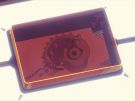
|
"It's frozen in hardened bakelite, but it's alive." |
Note: You will notice that The Geektionary occasionally uses first person references in violation of this site's standards and practices. This is the exception that tests the rule. Don't anyone else do this.
Note: The Geektionary is OLD, and much of the information here is a time capsule from the active days of the Eva Commentary project in the mid-2000s. As such, things have changed dramatically since this was written, and much of this has been rendered irrelevant or nonsensical come 2020. It is kept mostly for archival purposes, or as a nostalgic reminder of previous times. Don't take any of this as representative of the current state of the Evangelion franchise or fandom.
The purpose of The Geektionary is mostly humorous. Any barbs you see aimed at real people shouldn't be taken seriously, and should NOT be used as the basis of personal attacks against them in any manner.
Introduction
Like anything else, geeks have their own unique subculture, and Evangelion geeks are no exception. The aim of the Geektionary is to provide a little guide to the incomprehensible geek-culture saturating the entire commentary (the FGC community in particular). People who actually have lives are bound to ask these kinds of questions: “What the heck do all those acronyms stand for? What is this ReDeath they keep on mentioning, or Thumbnail Theatre, for that matter? And what's all that weird Japanese they keep on throwing in? I speak English, goddamit!”
Some terms, like “AMV” and “shipping”, are hardly specific to NGE geekdom, but we will explain their significance to the fandom nonetheless. For explanations of various other Internet geek memes you might see in use (like the omnipresent “n00b”), I recommend Urban Dictionary and Wikipedia.
| Geektionary: |
|---|
A
Addition Drama Track
To save Reichu's phalanges some effort, look here. Then, go here and download the picsub. There is little more to say.
ADV
Formerly a prominent name in the realm of anime localization, which acquired the NGE TV series when the Texas-based company was still young and localized it for western countries*. The English dub they produced remains — as part of the bigger, perpetually futile Dubs vs. Subs debate — an apple of discord within the NGE community (As of 2020, their dub has received a surprising level of renewed appreciation after the Netflix dub ignited controversy of its own). Their pre-Platinum releases were not, like many domestic anime releases of that time, up to par with the expectations of today. While the horrendous picture quality was not their fault, the translations used for both the subtitles and the dub obscured, distorted, or outright erased many of NGE's finer points — thus making deeper understanding of an anime that so heavily utilizes subtlety more unobtainable than would a reliable translation. (And the dub, by the very nature of dubs, exacerbated the problem.) Other strikes against ADV include:
- The promotion of misinformation via the descriptions on the video packages and “supplemental” materials included in their releases.
- Their failure to wait for the Japanese video releases of the final TV episodes, resulting in an unnecessarily long wait for the NPC episodes. (But as an unintended “bonus”, this meant that we did get the original TV cuts of these episodes. ::p)
- The utilization of overlays in the Collection volumes.
- Their decision to release Platinum in such close proximity to the long-delayed release of the Director's Cut episodes. Getting the pre-Renewal NPC episodes locally is still a boon for completists, but this bad commercial decision — “bad” as in “respectability meter down another point”, not “bad” from the cold and inhuman money-milking POV — was still a peeve for many.
- No need to go on with various other minutiae… Despite the bad timing of Platinum, ADV has largely redeemed themselves with it. See Platinum for more details.
- I'm only certain about the US, UK, and Canada. Not sure about elsewhere, or how releases lacking the ADV label were, or weren't, connected to ADV. Anyone?
Angel Tower
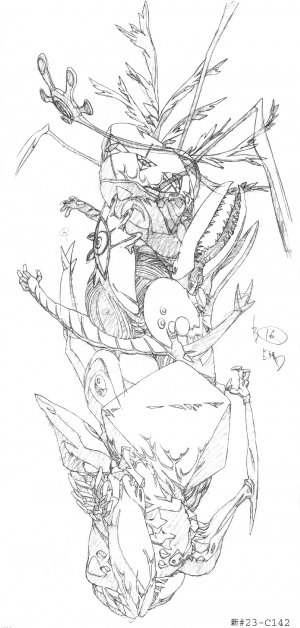
The grotesque form that bubbles out of EVA-00's back in episode #23', a conglomeration of Armisael's dead siblings, immediately after Rei's metaphysical interchange with the 16th concludes, and a matter long perplexing fans. Infrequently referenced by its Japanese equivalent, "shito no tou" 使徒の塔. Coined by Reichu.
Angelic Days
See Love Eva.
Anti-shipping
See Shipping.
AWL
Amanda Winn Lee, the dub voice of Rei and ADR director for the English adaptation of the two movies (and unofficially for parts of the TV series). She has earned a harsh reputation among most of us geeks for a number of reasons — most highlighted by her Commentary of Evil. This acronym is particularly useful because, as tv33 put it, “Her true name is too evil to be typed in full.”
AU
Alternate Universe. This acronym is certainly nothing new, but in NGE fandom it specifically refers to the infamous sequence from episode #26, wherein we get a frightening glimpse of what NGE might have been like were it a teenage school romance/comedy… without Evas or Nerv, and with a Rei who is Rei in appearance only. A lot of people seem to think that this sequence is the pinnacle of the series, but Reichu thinks that said people are all missing the point. This particular AU was elaborated upon in the video game Girlfriend of Steel 2, but… well, look here.
- The live action sequence that was cut from EoE could also be considered AU.
B-C
BIB
Big Irony Bomb. I.e., this.
Bridge Bunnies
"Bridge Bunnies" is the light-hearted fan-nickname given to the team who works on the "bridge" of Nerv headquarters; the trio of Maya Ibuki, Makoto Hyuga, and Shigeru Aoba, although the other unnamed operators are also included under this definition.
| The Bridge Bunnies | ||
 |
 |
 |
Commentary of Evil
A term, popularized by Dr. Nick, that refers to the notorious commentary track spanning Manga Entertainment's two NGE releases (Death & Rebirth and End of Evangelion), featuring Amanda Winn Lee, Jason C. Lee (her husband and dub voice of Aoba), and Taliesin Jaffe. While the track has some comedic merit, it is good for little else, packed head-to-toe with misinformation and shameless endorsement of the movies' dub (which even NGE dubbies tend to agree is a disappointment!) and the oftentimes horrifying decisions she made producing it (including this one). Jaffe gets a break because he at least attempted to present some worthwhile material, even if he wasn't 100% on track either (“Samhel”?). For something meant to accompany a very complicated and serious work of art, their commentary is offensively inadequate.
While we may make a mockery of the commentary and the lack of Evangelion knowledge displayed therein, it is important to point out in this new internet "age of rage" that we DO NOT condone personal attacks against Amanda Winn Lee or anybody else involved in the production of the commentary or the ADV English dub. We condemn any personal attacks or hatred directed toward any former ADV staff as utterly abhorrent.
D-E
Doujinshi
Often shortened to Doujin (同人), are self published japanese works such as artbooks, manga, or novels. Doujinshi are often created by amatuers and on some occasions professionals self-publish works as side projects. Many doujinshi artists work in groups called circles and many sell their works at a bi-annual event in Tokyo called Comiket. Many doujinshi works are spin-offs or parodies of existing official anime and manga, and are often adult oriented (pornographic).
ED
Ending. I.e., the ending sequence of an anime (you know, the one that has credits and stuff). Genuine anime industry shorthand, BTW.
EGK
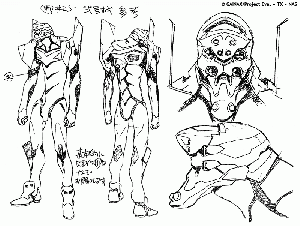
Evil Gekijouban* Kyoko(-sama). EGK — which probably resembles a gagging noise on purpose — is the EVA-02 who resulted from a most unfair design overhaul that was somehow deemed necessary for EoE. At best, gekijouban EVA-02 has a slightly modified head design, shrunken pylons, a slight slouch, and the body proportions of a harpy. At worst, the animator of a large number of cuts for the UBF turned her into this: :screams in horror:
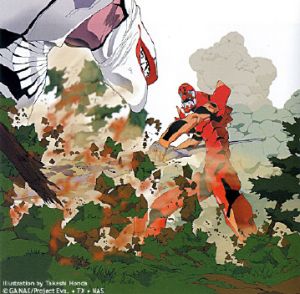
The latter is so completely abominable, it merits a new acronym: REGK (REALLY Evil Gekijouban Kyoko). What's really strange is that Takeshi Honda did the cited illustration of REGK, along with an illo for the Reprise of Evangelion CD where EVA-02 has the same frelled-up head design. Is he the one responsible for those dodgily-drawn cuts in #25′?!?
- For those not in the know, gekijouban means “theatrical edition” and is generally used in reference to, well, a theatrical adaptation of something that wasn't theatrical to start with — sort of like saying “<title>: The Movie” or “<title>: The Motion Picture”. With regards to NGE, it refers to both D&R and EoE — but, here, we specifically mean EoE, since it's, you know, the NGE movie.
A short comparison between the original EVA-02 featured in the series and the EGK is available in this forum post (warning: possible Rebuild spoilers!).
EMK

Evil Manga Kaworu. Sadamoto's Kaworu is a stalker who kills kittens, and the gentle, elegant Kaworu of the anime isn't; ergo, the manga Kaworu is Evil. Well, it's a popular fan sentiment, anyway (and requires an acronym for easy reference, which was provided by Magami No ER). The "kitten-killing" part inevitably inspired some unknown individual to weave a spin-off on a certain infamous meme involving kittens, Domo-kun, and God, which is: "Every time you masturbate, Kaworu kills a kitten". Although some continue to extract endless entertainment from Kaworu's autosex-inspired felinocide, others wish it would just go away. However, Evil Manga Kaworu has reportedly said, "This meme is destined to live forever, even though it may result in the destruction of the human race." While this comment seems contradictory at first -- as the continued existence of the joke results in the death of kittens and not humans -- there is perhaps some truth to it.
EoTV
End of TV. Specifically, this refers to episodes #25 and #26 as the counterpart of EoE episodes #25′ and #26′. An exceptionally useful acronym.
EU
Expanded Universe. This idea is quite familiar to the geek: The universe of a franchise is “fleshed out” with apocryphal media (books, video games, collectible card games, etc.) that satisfies the fans' collective lust for MORE!!!, while having the nice bonus of putting lots of dough into the pockets of a select few. NGE is no exception, of course, and its EU includes such wondrous [/sarcasm] things as the original Sega Saturn, Second Impression, and Girlfriend of Steel video/computer games and the Evangelion RPG. These items aren't canonical by any means, but they provide new characters like Mana Kirishima and Mayumi Yamagishi (i.e., alternate side dishes for fapboys), various new Angels, and kickass mecha like the Toyota T-RIDEN-T Land Cruiser.
"Every time you masturbate, Kaworu kills a kitten."
See EMK.
F
Fan Art
Often referring to unofficial artwork by amatuer artists using existing media as the subject matter.
Fanfiction
See Fan-Geek.
Also see Evangelion section on FFN
Evangelion ficdom is notorious for its high opinion of itself. It exhalts it's awesomeness and superiority over all other lowly forms of fanfiction like Naruto, or DragonBall Z, or even the Harry Potter section. While this may once have been true, one look at the above link will quickly prove that this is nothing but bollocks. It also maintains the unique ability to take itself insanely seriously... to the point where people forget it's supposed to be one huge laugh.
Evangelion fanfiction comes in several flavours:
- WAFF (Warm And Fuzzy Feeling):
- Everyone lives happily ever after. Regardless of established characterisation, universe rules or plain good taste. Usually involves Pairings...which are even worse.
- Darkfic:
- See above... only everybody dies in the end. Horribly. Including Pen-Pen. Usually used by authors to beat out their frustrations from their own lives on harmless fictional characters.
- Post Third Impact:
- For those for whom the end just wasn't good enough. Usually either a WAFF or a Darkfic. Usually lacks the depth of the original series.
- Lemons
- Tongues, Toys and Tentacles.... Avoid at all costs unless you want to know what Asuka felt like beneath Arael's spotlight of doom.
- Self Insert:
- For those for whom real life just isn't good enough. The lowest of the low. Those who hate themselves so much, they adopt their own idealised persona, bed everything with a pulse in the ::universe, and frack things up faster than the JSSDF on Impact-Day. Not to mention the fact that a good deal of them seem to be better suited to fictionmania...
Fan-Geek
See Geek.
Fan Service
Fan Service is when the production team of a series inserts material that does nothing to move the plot along but just exists to give the fans a thrill.
When they hear the term "fan service", most people tend to think of sex and nudity: a typical example of such ecchi fan service in NGE would include Misato leaning forward at the dinner table in Episode 02, giving Shinji, and the audience, a good look at her cleavage, and the subsequent shot of her backside in tight shorts. However, it is important to note that not all nudity is considered fan service. Rei's nudity in Episode 05 and Asuka's exposing her breasts to Kaji in Episode 22' give the audience important information about their characters, and should thus probably not be considered gratuitous. The term fan service is also used to describe various other things including gratuitous action and explosions. Misato's Alpine A310, references to old science fiction movies and even the cans of Yebichu beer classify as "fan service".

Gainax is semi-notorious for the adding the "Gainax bounce" (first introduced in the Daicon IV opening animation) into anime series they have created, in which female characters' boobs will jiggle to an unusually large degree when they move.
While bounce-wise Evangelion is rather restrained for a Gainax series (especially in comparison to some of the studio's later works like He Is My Master), there are still plenty of suggestive scenes to go around, and in early episodes Misato actually previews next week's upcoming episode by promising "...and more fan service!" Promises of fan service have become a minor Gainax tradition and they've been recycled in episode previews in Mahoromatic and Magical Shopping Arcade Abenobashi.
You might also want to read Reichu's essay-post in the forums on excessive sexual objectification in NGE merchandise (another topic that invariably leads to naked Evas).
Fanwanking
A term, sometimes used in a deragatory intent, used to describe the act that fans of a work sometimes do to fill plotholes (or just missing links within the narrative) within the work, often employing specific facets or elements of the work while adding new ones. Because details or plotpoints are often added into the attempt to fill in plotholes, these explanations are not considered "official" or "canonical". While some fanwanking may be rampant and done purely for fun, there are some fanwanks which are consistent enough with the original work and fills in the plotholes so nicely that other fans will jump on the wagon. Although these are sometimes referred to as "Fan Theories", they are still contested to this day and should not be considered canonical.
Among some of the popular subjects in Evangelion to fanwank are
- What Gendo said to Ritsuko in EoE
- Details of Second Impact
- Details of Third Impact
- Evangelion Unit-00's Soul
- Kaworu in Nerv's Terminal Dogma, mistaking Lilith for Adam
- The 15 Seele Monoliths in Episode 24'
Fuzzy Logic
This pun on the algebraic term is an endearing reference to our old friend Fuzzy Chickens (see Troll), whose thought processes were oftentimes frustratingly — and famously — unfathomable: in other words, “fuzzy” (definition 4). An example of "Fuzzy Logic": Fuzzy claimed to disbelieve that Rei had Lilith's soul. When it was pointed out to him that Kaworu said to Rei, "We have both taken the Lilim's form on this planet," Fuzzy replied, "So what? So has everyone else."!!! Fuzzy also once opined that the "real reason" that Rei slaps Shinji in Episode 05 is because she was being deliberately sexually provocative in the infamous "glasses" scene and had been doing a slow burn all during their trip to HQ because he didn't do her on the spot.
G
Geek
Here this term is used in an entirely neutral way, implying no more than (to borrow from Wikipedia) "a person with a devotion to something in a way that places him or her outside the mainstream. This could be due to the intensity, depth, or subject of their interest." A "fan-geek" is simply a gender neutral variation upon "fanboy" or "fangirl" -- but, again, has only neutral connotations at FGC.
Gender
This entry is kinda long, so I'm giving it its own page. (Warning: Said page is, like some other things on a this site, a rather out-dated relic which will be replaced with much better things soon enough.)
GNG
Giant Naked Gendo. A theoretic entity that would have appeared if Gendo's plan for Instrumentality had succeeded. A counterpart to Giant Naked Rei and Giant Naked Kaworu.
GNK
Giant Naked Kaworu. The counterpart of Giant Naked Rei: the gargantuan, nude, and sexually androgynous Kaworu that briefly appears in EoE to calm poor Shinji's overtaxed senses (and do other mysterious things). While this acronym seems blindingly obvious in retrospect, HeWhoPostsStuff was the first one to put it to use.
GNR
Giant Naked Rei. One of the most beloved acronyms, and also one of the most useful. This refers to the giant Rei from End of Evangelion, produced by the conglomeration of Rei 3, Adam, and Lilith (eventually sucking up the Tree of Life -- EVA-01 and the Spear of Longinus -- for good measure). Sadly, no one knows where this acronym originally came from.
GOS
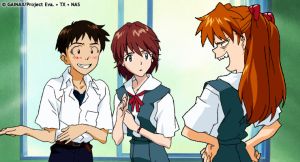
Girlfriend of Steel* (from Koutetsu no Girlfriend 鋼鉄のガールフレンド). An EU side story/dating sim released for the Sega Saturn and PC back in 1998, placed at around the end of the Action Arc (after #13, perhaps?). It is lent some “authenticity” by the fact that actual anime staff did work on it: Sadamoto and Yamashita contributed new character and mecha designs, the seiyuu reprised their character roles, it was illustrated by animators from the show, and so on. However, “playing” it is akin to sitting through a couple-hour-long fan-fiction presented in Flash format — albeit a Flash with almost no actual animation to speak of, the game instead resorting to cut-out characters moving around (think motion tweens) on painted backgrounds, if they move at all. Likewise, there is virtually no interactivity at all, but, apparently, sitting through these “A/V novels” is par for the course among Japanese gamers.
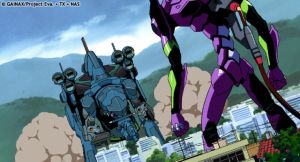
Suffering through GOS should be considered a rite of passage for NGE geeks, so I'll keep the synopsis short and spoiler-free. Essentially, GOS revolves around a new character named Mana Kirishima (who continues the NGE tradition and has a surname taken from a WW2 naval vessel), who shows up as a transfer student in Class 2-A. She's a nauseatingly cute, genki schoolgirl (voiced by Megumi Hayashibara) who immediately begins hitting on Shinji — since, you know, Shinji is 100% babe magnet and all. But, oh, what a dark secret she holds! Could it possibly have anything to do with that giant robot (the T-RIDEN-T Land Cruiser) that's prowling around Tokyo-3 at night? Or that hospitalized kid who drove his mecha off a waterfall? Or the really weird way Shinji's superiors at Nerv are acting? This couldn't be some kind of conspiracy, could it?!? Further questions abound! Will Asuka succeed in keeping her Baka-Shinji away from that Mana tramp? More importantly, will Rei actually get more than three lines of dialogue?? Get ahold of the fan-translated PC version if you just have to know!
The game has also spawned a beefed-up PS2 version released in March 2006, with the complimentary titles "Girlfriend of Steel Special Edition" (Koutetsu no Girlfriend Tokubetsuhen) and "Iron Maiden: Jesu, Joy of Man's Desiring". Apparently it has new scenarios, voices, animations, and even a new mecha designed by Yamashita-san (thanks for the tidbits, AA), but not much else is known right now.
- The official English title is actually “Iron Maiden”, but very few Westerners actually call it that, presumably because of the band by the same name. Shame — considering what an “Iron Maiden” is, the title is all-too-appropriate… (The title of a certain Iron Maiden song is also strangely applicable.)
*GOS2
Girlfriend of Steel 2 (as it is called among Westerners, even though the official English title is Iron Maiden 2nd). A sequel to GOS in spirit only: The only things this game really has in common with its predecessor are the dating sim premise (with much more dating this time around) and the basic gameplay engine. To avoid unnecessary work on my part, just check out my Walkthrough, which has a Q'n'A section at the beginning.
See also Love Eva.
-gouki
-号機 The Japanese way of saying “Unit # <so and so>”, usually in reference to pieces of machinery and other artificial constructs (like the Pokémon Porygon). This suffix is used in conjunction with the Evas' individual designations in spoken Japanese: So, even though a certain purple-clad Evangelion might have “EVA 01” written in big green letters on her arms and be referred to as “EVA-01” on computer monitors throughout the show, everyone speaking Japanese will instead call her “Shogouki” (with the sho meaning “first” and not “one”, for some incomprehensible reason; it's a -gouki tradition not limited to NGE). Of course, ADV/Manga's localizations do NOT use the “EVA-##” setup presented as the English equivalent for “-gouki” and instead just do a literal translation, resulting in “Unit” this and “Unit” that.
Due to some strange personality quirk, I hate to see Evas being called “units”. (It's probably Butt-head's fault.) Then… in translation, the tradition of substituting “#-gouki” with “EVA-##” poses certain problems when the “#-gouki” is preceded by “Eva” or “Evangelion”. In those instances, you will see in the FGC scripts that I do, in fact, resort to that horrible “U” word after all. Thus, “Eva Shogouki” becomes "Eva Unit 01".
To the point, despite the fact that Shogouki, Nigouki, etc., are terms that essentially treat the Evas like pieces like machinery, I got into the habit of using them on forums because (A) they sound cool when pronounced correctly (hint: ou is a long “o”, like in … grope), and (B) having them as alternatives to the usual monikers spices up NGE conversation. As with many things, this habit eventually began to catch on, and -gouki mysteriously started showing up in other people's posts… Anyway, here's the run-down so you can use these appellations yourself.
| Japanese (kanji) | Japanese (romaji) | English Equivalent |
|---|---|---|
| 零号機 | Zerogouki | EVA-00 (Unit 00) |
| 初号機 | Shogouki | EVA-01 (Unit 01) |
| 弐号機 | Nigouki | EVA-02 (Unit 02) |
| 3号機 (or 参号機) | Sangouki | EVA-03 (Unit 03) |
| 4号機 | Yongouki | EVA-04 (Unit 04) |
| 5号機 (or 伍号機)、6号機、7号機、8号機、9号機、10号機、11号機、12号機、13号機 | Gogouki, Rokugouki, Nanagouki, Hachigouki, Kyuugouki, Juugouki, Juuichigouki, Juunigouki, Juusangouki | EVA-05, etc. (Unit 05, etc.) |
Ultimately, these monikers are okay, because one can simply change the kanji and turn them into names without any mechanical connotations whatsoever! Take -gouki for example… If you form it with the kanji 強鬼, it means “strong oni”! (Or something like that. It's apparently a real kanji compound.) </lame justifier>
Greenfield, Matt
The president of the ADV Empire, husband of Tiffany Grant (VA of dub-Asuka), and a figure of some notoriety amongst many NGE geeks — primarily owing to his tendency to talk pretentiously about aspects of the show he knows very little about.
GSF
Archaic. Genetically Similar Facsimile. Created by tv33 as a replacement for the term “clone” in reference to the relationship between the Evas and Adam, due to my consistent bitching about how the Evas cannot be “clones” of anything considering the physical variation they exhibit amongst themselves. GSF ends up being an oxymoron, though, since ”facsimile” is essentially synonymous with “clone” — which sorta defeats the ”genetically similar [but not quite the same]” part.
Entries penned (or simply assembled) by Reichu unless otherwise noted. Harsh statements about certain individuals are only expressions of geeky displeasure with their NGE-related flubs, not assaults on their actual persons. There's an important distinction.
H-K
Harpy
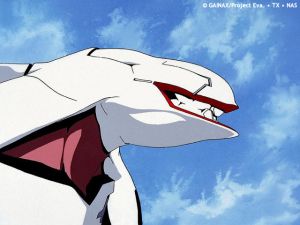
One of the Mass Production Model Evangelions. A harpy, in case you weren't aware, is a creature from Greek mythology — part woman, part predatory bird, and generally unpleasant. (Well, that definition of “harpy” might be a perversion of the original intent, but … whatever.) The name is delightfully appropriate for NGE's “Eva Series”, and so it has stuck. Interestingly, the idea to call the MP Evas “harpies” appears to have emerged multiple times independently, as many great ideas do.
HIP
Human Instrumentality Project. The actual Japanese term is Jinrui Hokan Keikaku, which means something like “Human Complementation Project”. However, Anno decided to confuse everybody and use this opportunity to sneak in another gratuitous sci-fi reference [will elaborate more later], so the official English rendition of J.H.K. is “Human Instrumentality Project”, even though “complementation” and “instrumentality” mean completely different things. Oh, well.
Iron Maiden
See GOS.
Kanji
Kanji are the part of the Japanese writing system that have been borrowed directly from the Chinese writing system, as opposed to Katakana and Hiragana. They are ideograms and are not phonetic, therefore requiring the memorization of the ideograms in order to understand the meaning. Although most of the borrowed words retain the same or similar meanings as they did in Chinese, some words have different meanings from the Chinese counterpart.
KFR
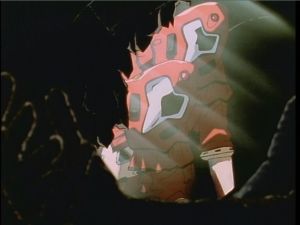
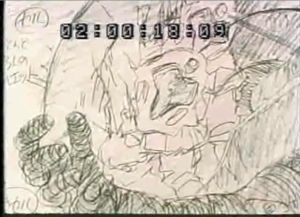
Kentucky Fried Rei. The corpse of Rei 2 that was (against all probability and logic) recovered by Ritsuko-tachi after Tokyo-3 was vaporized. Created on a whim (by Reichu — who else? @_@) for entirely silly purposes, in vague reference to Shin-seiki's assertion, “I think the gruesome truth is [Rei 2] was roasted alive in the plug.”
Kyoko-sama
In the same vein as Yui-sama — a more “PC” way of referring to EVA-02 (by the name of her soul, rather than by a number), while acknowledging (in typical Reichu fashion…) that becoming an Evangelion has made her great and worthy of the -sama suffix. Extremely silly, but eventually, like “Yui-sama”, other people started using it without any prompting from me…
L
LCL
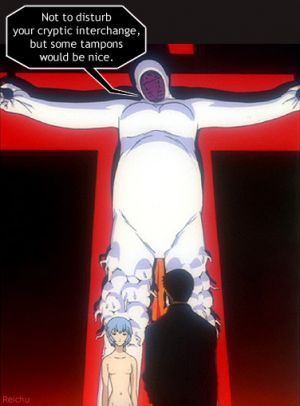
Who the hell knows? The EoE Theatrical Program actually bothered to tell us that it isn't “Link Connect(ed/ion) Liquid”. Strangely, it doesn't say what it actually DOES stand for. Bastards. Shin-seiki has suggested that it stands for “Lilith's Creation Liquid”, which is a distinct possibility. Given its source, an alternative expansion for the “C” has also been proposed by AchtungAffen…
LAEM
Live Action Evangelion Movie. This is a project that ADV started around 2003, to the horror, anxiety, or, perhaps less frequently, anticipation of NGE fan-geeks everywhere. With nothing but a script and a handful of concept art by WETA's artists, they promoted the project shamelessly, even including featurettes on their "Directors' Cut" DVDs. Many futile threads emerged debating over whether or not the movie would suck, although things settled down somewhat when, two years later, absolutely no news had emerged. This most impeccable acronym began when Dr. Nick mused, “Hmm, LAEM… I like that acronym. It resembles the word LAME delightfully well.” No more needs to be said, really.
Live Action Sequence
Remember that weird EoE trailer at the very start of the movie, with all the live action shots that were, well, nowhere in the actual program? Aren't you just dying with curiosity? Go here, NOW. ^_^
LnY
Longinus no yari (= Spear of Longinus). A proposed replacement for LoL, but nobody really seems to use it.
LoL

Lance of Longinus. This term* was used without a second thought until we learned that “Spear of Longinus” is the official English rendition of Longinus no yari (as proven by a computer screen in #25′) . That “spear” is used is not terribly surprising, considering the very weapon for which the Red Pitchfork of Doom was named is commonly referred to as the “Spear of Destiny”; and, for my part, I've never heard of Jahshua Ha Mashiyach (or Jesus Christ, if you've never heard of the other guy) being poked with a “lance”. Debates have ensued about exactly which type of weapon (spear or lance) the thing in NGE really is, with conclusions being reached on both ends. But, let's face it… In Japanese, “spear” and “lance” are the same word (yari). In Latin — Longinus was a Roman soldier, after all — lancea can mean both “spear” and “lance”. Heck, the Greek word (logche) that references the thing in John 19:34 can apparently mean both. EoE says it's a “spear”. So call it a goddamn spear! Or, alternatively, we could make everyone happy and call it the "Bident of Longinus".
Since the acronym SoL was already used, LnY was proposed as a replacement. This doesn't seem to have quite caught on, though, since, even knowing that calling it a “Lance” is incorrect, a lot of people just can't seem to stop doing it, presumably because (A) “Lance of Longinus” rolls off the tongue, and (B) the acronym is funny. (lol!!!11)
I suspect this silly argument will find its way into an appendix eventually. Better than hogging space here.
- Mr. Tines notes, “‘Lance’ was drawn from Arthurian usage, if nothing else. The usual place (outside NGE) to find mentions of the weapon is in the context of the Dolorous Stroke inflicted on King Pellam by Sir Balin; and even though Malory describes the weapon as ‘that was the same spear that Longius [sic] smote our Lord to the heart’, the weapon is more often referred to as a Lance (given the association with knights in armour).”
Love Eva
A nickname for the “Girlfriend of Steel 2” manga, in homage to Ken Akamatsu's Love Hina. For the English adaptation published in ADV's Newtype US, it was retitled Angelic Days.
LTP
see Literal Translation Project
M
Mangle Entertainment
Used in reference to Manga Entertainment, which is somewhat notorious for botching its anime releases — not to mention sitting on major licenses for years. :cough:Gunbuster:cough:
McCoy, Sean
“If Matt Greenfield is Batman, Sean McCoy is the Boy Wonder.” —Dr Nick. For actual information, see Platinum Special Features.
MP
Mass Production (Model Evangelion) = Eva Series (or harpy).
Mythology of Evangelion
See Platinum Special Features.
Entries penned (or simply assembled) by Reichu unless otherwise noted. Harsh statements about certain individuals are only expressions of geeky displeasure with their NGE-related flubs, not assaults on their actual persons. There's an important distinction.
N
Nigouki
See -gouki.
Nissan
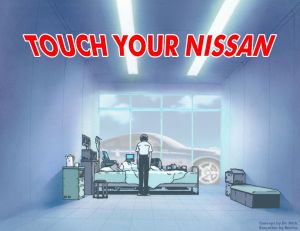
You know the world is about to end when even the great Hideaki Anno has sold his soul to appear in a car commercial. What's even richer than that is this particular advertising campaign's slogan: “Touch your Nissan”. Hmmm… Sounds like another “euphemism”, if you know what I mean… :wink wink nudge nudge:
NPC

|
"Fortunately, the MAGI system can be transplanted. We can return to work tomorrow." |

New Production Cut. While looking through my Groundwork of Evangelion books, I stumbled across the term shinsaku KATTO 新作カット (literally, “new production cut”) used in reference to the material added to the Video & LD versions of episodes #21 ~ #24. While the updated versions of these episodes are officially referred to as the “Video & LD” versions, this terminology is very confusing to poor Westerners who have been acquainted with NGE by way of ADV: Rather than having their releases correspond directly to those of the Japanese, ADV instead gave us the televised versions of episodes #21 and up with their initial video cassette and DVD releases of Evangelion. (This is because the Japanese video releases were delayed as a result of these episodes being reworked, and ADV wasn't of the mind to wait.) When ADV finally did release the Video & LD versions of those four episodes domestically, they were christened the Director's Cut episodes — although this terminology is also confusing, since it leads some to believe that material was CUT from the original release, whereas, in actuality, all of the added and modified material was produced specifically FOR the video release. “New Production Cut” is thus more useful among Westerners than “Video & LD Version” and less ambiguous than “Directors' Cut” — so I zealously promoted the usage of the term.
As it would go, though, later findings led me to believe that shinsaku KATTO referred NOT to episodes #21′ through #24′ in their entirety, but only to the cuts produced anew for them. Ergo, any additional or modified cut (not in the original OA version) would be a “newly-produced cut”. The term apparently also refers to the cuts produced exclusively for DEATH. However, since my efforts have already acid-etched “NPC” into the brains of my cohorts, it has become a bit too late to revoke the acronym on account of what is essentially a technicality. It remains useful, so it might as well be used.
Nucleola

|
"Fortunately, the MAGI system can be transplanted. We can return to work tomorrow." |
(Pl.: nucleolae) EVA-01 possesses two (later, four) of what look like miniature cores around the big one, but what exactly these things are is never elaborated upon.
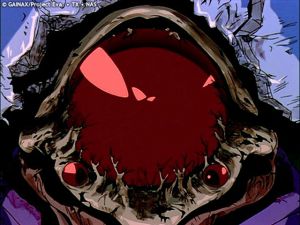
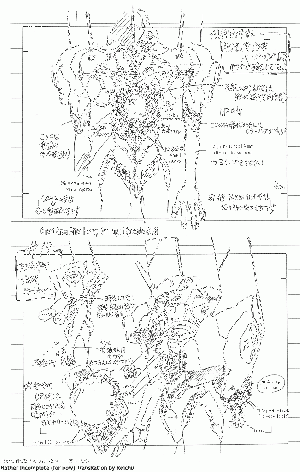
Production drawings refer to these only as chiisana na koukyuu, or "small light-spheres/cores" (koukyuu is used interchangeably with KOA , "core"). Since "small light-spheres/cores" is rather ungainly, Reichu fabricated the term "nucleola" (the feminine diminutive form of Latin nucleus, "kernel" or "core") as a general-purpose substitute. ...then again, nobody really uses it.
O-P
OP
Opening. I.e., the opening sequence of an anime, or whatever. Like ED, this is genuine anime industry shorthand.
Pierre
See Seele Dudes.
Platinum
The domestic release of Renewal, minus the movies (Death and EoE) owing to the fact that Manga is sitting on the license (and apparently lacks the sense to obtain and localize the remastered movies).
The presentation is minimally altered from the original Japanese release, down to including translated versions of the booklets included with the individually-released Renewal volumes (although the actual content has been distributed in a different manner). Titles are soft rather than permanently imposed onto the picture. And, yippity skippity!, the subtitle translation has been finely tweaked, 95% of the time for the better, rendering these scripts the best ones currently available for the TV series. There are some complaints, such as the absence of any of the Renewal DVD Box-Set's extras save for the animatics included on the bonus disc, along with the suckage of all other included extras. Additionally, the image is not as crisp as Renewal's (but, bizarrely, Platinum gives us MORE of the picture), the DVD menus do not undergo the same progressive change from first disc to last (i.e., they retain the same look throughout), the scrolling notes from the DVDs were not translated for inclusion, and so on. I guess we can live, though…
Platinum Special Features
With ADV's domestic release of the remastered TV series, they attempted to out-do prior efforts (e.g., the Commentary of Evil) with their own substandard “bonus” features. This included, of course, commentary on select episodes featuring Matt Greenfield (Head honcho of ADV) and the various dub actors who worked on NGE. The initial commentaries were mostly useless — focusing on localization, dubbing, and western fandom — although this could be considered a blessing in disguise, since, by not touching the meat of NGE, they didn't get to prove how utterly little they actually knew about the show. Too bad it didn't last. Soon enough, Greenfield dug up an NGE fan who he felt would add some actual insight on the show to the special features.
And, thus, the name of Sean McCoy began its descent into infamy. None of us had even heard of the guy. Seems he used to prowl Usenet in the late 90's, spreading some rather … interesting theories, notably the one about how Shinji and Asuka had sex in EoE, and Asuka's final words (“Kimochi warui”) were in direct reference to morning sickness. What ended up on the DVDs wasn't any better. The commentary tracks featuring him are bad enough, but the real offender is the two-part special feature entitled The Mythology of Eva, wherein Greenfield and McCoy join forces to conjure misconceptions far more potent than either could achieve alone.
It bears repeating that while we make fun of McCoy and Greenfield for their demonstrated lack of Evangelion knowledge here, our mockery extends no further than our frustration as fans. We absolutely condemn any personal attacks or hatred directed against either of them in any form.
Pre-3I Instrumentality (P3II)
This is a term coined by Shin-seiki to refer to the weird sequence in #26′ that involves a mind meld between Shinji, Asuka, Misato, Rei, and Ritsuko — beginning with the "sandbox" scene and ending with Shinji choking Asuka in the kitchen — just before the consequent Third Impact and 'full-fledged' Instrumentality occur. There are those who claim that it was 'all in Shinji's head', although this idea is easy to rip apart due to its many holes.
Q-R
Quantum Magic
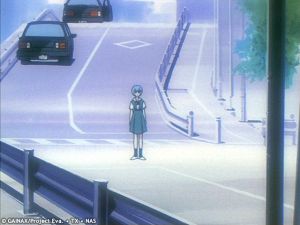
A term coined by Reichu as a short-hand reference to an idea I proposed as a possible explanation of certain phenomena in NGE (for the most part associated with Rei) which seem to violate the ordinary constraints of time and space. Notable examples include the apparent simultaneous existence of Rei's soul in Rei 2 and Zerogouki, and the temporal paradox of the Rei apparitions that appear before Misato and Ritsuko in #25′, even though Rei doesn't return to Lilith until #26′. There are various references to sub-atomic physics and quantum mechanics throughout the series: for example, the Dirac Sea; the references to quarks, etc., among the graffiti in Rei's birthplace in Terminal Dogma,
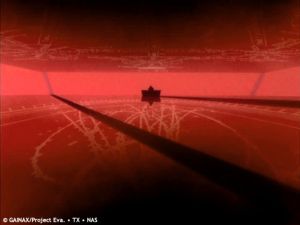
and the image on the floor in Gendo's office, which appears to depict the tracks of high-energy atomic collisions in a cyclotron. In light of these, it has occurred to me that if one posits the notion that souls in NGE function in a manner analogous to some of the counter-intuitive parameters of behavior of sub-atomic particles — e.g., that a single electron may, in certain circumstances, be said to exist in two places at once — that quantum mechanics famously entails, some sense could be made of these soul-related paradoxes. ~Shin-seiki
RCB
Red Cross Book. This is the typical gaijin way of referring to the untitled End of Evangelion theatrical program book. However, those of us who want to be cool and hip (or possibly just pedantic) go to the trouble of actually writing out "End of Evangelion <insert description of choice>".
REGK
See EGK.
Reiquarium
The LCL-filled tank inside the Dummy Plug Plant containing Gendo's backup stock of Rei clone bodies, the number of whom changes depending on which version of the scene you happen to be viewing. And, to make a portmanteau out of a portmanteau: The Shinjiquarium is a bizarre variation upon one of the Reiquarium shots (the clones lifting up their heads in unison) occuring in EoE, wherein the Rei faces morph into Shinji faces -- but their bodies remain the same! (We already knew that Shinji Likes Boobies™, but this is ridiculous...!!)
RIAO

Rei in Appearance Only. This primarily refers to the much-beloved Rei of episode #26 (and expanded upon in GOS2), who looks like Rei and sounds like Megumi Hayashibara, but has, in fact, about as much in common with Rei as Cthulhu has with a Care Bear. This Rei is a hyperactive, genki schoolgirl, a far cry from the quiet, heavily introverted Rei with whom we are more familiar. Some people (many of whom claim to be Rei fans) say that they like RIAO because she represents what Rei would be like if she had grown up under more "ordinary" circumstances. While the portraits of the other characters in the "possible world" sequence of #26 are plausible, Rei is, on a very fundamental level, incapable of being AU Rei. For one thing, her basic personality is against it… But this ultimately becomes a nature vs. nurture argument that is best discussed in full elsewhere (and certainly will be further on down the road).
RIAO may also refer to the various OOC (out-of-character) incarnations of Rei that appear… well… bloody everywhere (like in 90% of her merchandise)!
RNR
Regular Naked Rei. That is, a naked Rei that is NOT giant. I invented this in a thread where I was attempting to calculate the total height of GNR by using the Black Moon and EVA-01 for scale, imposing them on an image of normal-sized Rei because a head-to-toe image of GNR does not exist. RNR here became useful as a means of distinguishing Regular Naked Rei from Giant Naked Rei. Absurd, but for some reason it caught on… (Haven't heard it used recently, though.)
Rubber Science
Including the sub-discipline “rubber physics”, this is defined as “an explanation which, although probably false according to what we know of the universe, sounds technical and convincing”. Sound familiar? NGE has sci-fi elements, even though most of these are pretty rubbery. Then, hard science isn't really the point: The coolness factor comes first, and then the show only needs to make itself at least seem credible enough for suspension of disbelief to kick in. (Although sometimes this results in a misuse of scientific concepts and terminology on par with the self-servicing butchery of Judæo-Christian tradition… but who cares?)
Ryousanki
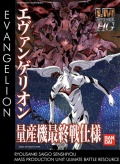
量産機 Literally meaning “Mass Production (Model) Unit”, this is a cool-sounding Japanese alternative (in the -gouki vein) to the usual terminology. Japanese materials commonly refer to the Mass Production Evas (see also harpy) by the rather vague “Eva Series”, which is sort of unpractical for two reasons: (A) “Eva Series” is misleading, since the term technically encompasses all Evas, not just the harpies, and (B) Japanese, being the way it is, uses “Eva Series” to refer both to the individual harpies and the group as a whole. (See e.g. the EoE script.) I ran into "Ryousanki" on the box covers of Bandai's EVA-05 model kits, although I'm sure it appears elsewhere.
S
Sammael

The true name of Satan — according to some, anyway, including Kabbalists, and, since we're talking about Evangelion, their concepts obviously take precedence. Sammael is represented in NGE by the twelve-winged angelic entity in the OP. Since Samm is the only angel to have twelve wings (because he's that cool), they're apparently telling us something by having GNR, and later EVA-01, sprout twelve wings in EoE. Strangely, Sammael himself makes absolutely no appearances in the actual anime, although he is secretly working behind the scenes, overseeing plot contrivances, setting up deus ex machinae, and keeping plot holes braced open so that the show retains enough structural integrity to make it to the bitter end. (At least, that's what he wants you to believe.)
BTW, anyone who calls him “Lucifer” will be neutered by Reichu with a rusty spoon.
Seele Dudes
Aside from Keel Lorenz, none of the Seele Big Five (the Instrumentality Committee) have actual names, just countries of origin. Out of "boredom", fanon ones were fabricated: Nigel Laforey (U.K.), Theodore "Teddy" Cassin (U.S.), Pierre Bretagne (France), and Vladimir Kaganovich (Russia). It began in May 2005: The reason for "Teddy" should be somewhat obvious, and I thought "it would be funny to give [the rest] given names that are really stereotypical", hence Pierre and Vladimir. tv33 suggested Nigel for U.K.: "That just screams limey." More "boredom" in January 2006 resulted in Seele08 and myself looking up the names of WWII naval vessels for the relevant countries. Shortly thereafter, the appellation process was complete.
Shekinah
A fancier way of referencing GNR. In Judaism, Shekinah is essentially the Divine Presence, but, in Kabbalism, it has a special significance and is treated as the feminine manation of God, which “can only be reunited with God through human fulfillment of all the divine commandments” (source). Although GNR is never specifically identified as Shekinah (or, rather, NGE's take on Shekinah), there is ample reason to associate her with the concept. Supposedly.
Shipping
“Shipping” is derived from “relationship” and refers to the universal geeky practice of (often quite passionately) advocating a romantic pairing between two fictional characters. Shipping is a popular pastime in NGE geekdom and most often revolves around who is best suited to Shinji:
Asuka (the most popular choice), Rei (the runner-up), Kaworu (the choice for yaoi fangirls), Misato, or <insert other character of choice>. Other common choices are Misato/Kaji (which, like Gendo/Yui, is one of the very few canonical pairings), Hikari/Toji, Ritsuko/Maya, and Rei/Kaworu — though pretty much any conceivable combination of characters is fair game, no matter how unbelievably farfetched, intentionally off-the-wall, or even downright wrong (with many-a-shady fan work exploiting the most disturbing possibilities). Non-canonical homosexual pairings are known as slash (referring to the “slash” that separates the names, i.e., Shinji/Kaworu). Shipping probably comprises the bulk of fanfiction, along with a heavy percentage of fan-art (oftentimes in the form of naughty pictures).
The opposite of shipping is known as anti-shipping, and refers to either (A) opposition to the phenomenon of shipping in general or (B) opposition to a particular pairing. Within our group, Mr. Tines is a particularly vehement opponent of Asuka/Shinji. (Although I should note, many of us don't "ship" Asuka/Shinji because we necessarily think they are well-suited to one another, but because we think it is the intention of the narrative.)
- “Shipping” is the noun, “to ship” is the verb, and a ”shipper” is someone who does it.
Shogouki
See -gouki.
Side Dish
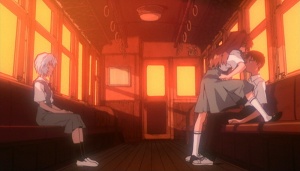
A Japanese metaphor used to describe something used as the focus of one's erotic fantasies. Asuka uses this metaphor in the "train" scene in The End of Evangelion. When the translation says: "Idiot! I know about your jerk-off fantasies of me." She actually says (in Japanese), "I know you've been using me as a side dish!" meaning that Shinji has only been using her in his fantasies without trying to establish an actual relationship. Since this phrase would be meaningless to any non-Japanese viewer, it is proper translation to use the effective meaning of her words, instead of a literal word-for-word translation. However, an early EOE fansub, by an outfit called Psychlo-Anime, apparently translated from a Chinese bootleg which made the translation even more muddled, actually used "I know you only think of me as food!" for this line, leading to much head scratching and confusion.
Singularity
See Transition Guide.
Slash
See Shipping.
Stay-Puft Marshmallow Woman
Archaic. “Stay-Puft” part optional. An affectionate “nickname” for Lilith, who often seems to be made out of the popular white confection. This term is derived from the movie Ghostbusters, at the climax of which the city is attacked by the "Stay-Puft Marshmallow Man".
Entries penned (or simply assembled) by Reichu unless otherwise noted. Harsh statements about certain individuals are only expressions of geeky displeasure with their NGE-related flubs, not assaults on their actual persons. There's an important distinction.
T
-tachi
See Rei-tachi.
Tang

The brand name of a popular orange-flavored drink. By some strange coincidence, it also happens to be a popular synonym for LCL — you know, being an amber-colored liquid that smells like blood and all.
Tangify
To become Tang. (See: Tang.) n. Tangification
Teddy
See Seele Dudes.
Theatrical Program Books
Three handsome, nameless A4-sized booklets that were published in association with the initial theatrical runs of the NGE movies (DEATH & REBIRTH and END OF EVANGELION). Instead of detailing them here, you will be lazily directed to EvaOtaku's site.
Transration
Sometimes "TransRation" (for emphasis). An Engrish version of the word "translation", pronounced the same except for the consonant substitution, and often used my me to refer to my own Japanese → English work due to its occasional dodginess. "Shadows of beeeeer!"
Transition Guide
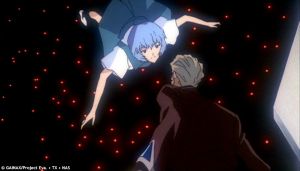
A term Mr. Tines appropriated from (Technological) Singularity geekdom as a shorthand for the Rei-tachi in EoE who go around and make people go “splat" (also commonly known as being "tanged"). This term is useful even if one doesn't know what the bloody hell the Singularity is, but, for the curious, the simplest definition seems to be, “The postulated point or short period in our future when our self-guided evolutionary development accelerates enormously so that nothing beyond that time can reliably be conceived.” (PHEW!) Having established that, a transition guide is defined at Accelerating Future as, “the bridge between modern-day humanity and the other side of a Singularity”, i.e. an agent of whatever Transcendent Power is born of the Singularity whose purpose is to ease the passage from pre- to post-Singular state. (I hope that makes more sense to you than me!) Mr. Tines has assessed the Singularity to be “a fair statement of the goal of the HIP”. An interesting comparison… I'm guessing that most of the Singularity geeks have been putting their faith in Ghost in the Shell-style scientific advances instead of alien technology, occult rituals, and the shameless misuse of Pointless Religious Symbolism, though Mr. Tines comments, “You can use alien transcendent technology if you have it — but can you ever trust it? See also Vinge's A Fire upon the Deep.”
T-RIDEN-T Land Cruiser
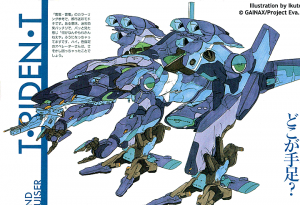
The appellation situation behind the giant robots introduced in the video game Girlfriend of Steel is poorly understood. AFAIK, they are never actually named in the game itself, although the section of Sore o nasumono dedicated to Yamashita's concept art has "T-RIDEN-T LAND CRUISER" printed in a corner top throughout. In the comment accompanying the finished design, Yamashita says:
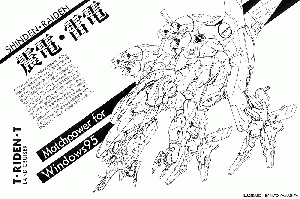
Since the creation process was completely finished, I was finally given notification of the official names: "Shinden" and "Raiden". Because I had wanted a class designation in the original name, the "mu" of "Gamu" (the mecha's temp name) was added onto "Raiden" as "T-RIDEN-T Class Land Cruiser".
Typical Japanese wordplay in action: The second kanji of Gamu (臥矛), pronounced mu or hoko, means "halberd" or "pike", and "sansa no hoko" (三叉の矛, or "three-pronged halberd") means "trident". Additionally, the English word "trident" converts into Japanese syllables as to-ra-i-den-to. Notice anything? "Raiden" is sandwiched between two occurrences of the syllable to: To-raiden-to. Or, when you put it back into English spelling with Caps Lock on, T-RIDEN-T. Cute, eh?
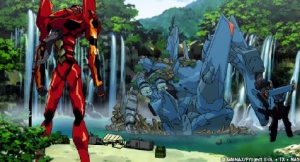

Of the three mecha pilots in GOS, Musashi's sexy, vaguely dinosaur-like 'bot is the only one that gets any real screen time in the game; Keita's only appears for one cut, having done a giant face plant off a waterfall; and Mana's doesn't appear at all. The latter problem appears to be corrected in the PS2 version of GOS, wherein both (A) a new mech designed by Yamashita debuts, and (B) Mana is seen in the act of piloting; so, unless further info contradicts this extrapolation, we'll just assume the mech is Mana's. The Eva Store refers to it as "Raiden", which sort of makes one wonder just what the hell "Raiden", "Shinden", and "T-RIDEN-T" specifically designate. Worst comes to worst, we can just call all of them Toyota Land Cruisers.
Troll
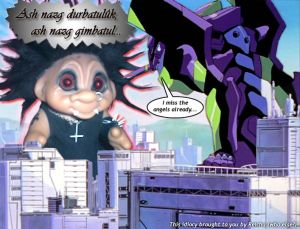
These well-known creatures of legend and infamy infest every corner of the collective Internets. Evangelion fora are no exception, of course, and we survived the onslaughts of many-a-troll during the grand ol' days of ANF. NGE trolls thrive on raiding the preexisting community and, rather than take the time to amiably ease themselves into NGE geek society and subject themselves to the usual rites of passage (most famously, the “Naked Eva Tolerance Test”), they proceed to attack the well-established theories in as smart-ass and inflammatory a manner as possible — or otherwise pollute the forum atmosphere with their rotten personalities. Not only are they usually impaired by Fuzzy Logic, they selectively ignore any evidence or argument that punches holes in their ideas, making them impossible to reason with and pleasant debate futile. A less severe subspecies of troll actually possess a SURFEIT of logic, which enables them to mathematically “prove” that others' ideas are wrong while “proving” that their own ideas are correct. No NGE trolls yet encountered have proven themselves as truly grand as our two favorites, the immor(t)al Fuzzy Chickens (Fuzzy Logic's namesake) and RahOtaku, two names that will surely turn up during our adventures in Commentary Land.
U-Z
UBF
Archaic. Über Bitch Fight. The bitch fight that's so big, it's über — i.e., the battle between Kyoko-sama and the harpies.
ve/ver/vis
Native speakers of English are undoubtedly familiar with the limitations of the available pronouns. Among the choices for third person singular, we have “he” for males, “she” for females, and “it” for everything else. Obviously, things become problematic when one needs to refer to entities that are either (A) of indeterminate gender (sometimes by their own intent), (B) unspecified gender (requiring awkward phrasing like "he or she"/"him or her"/etc. or laborious rewording), or (C) possess no biological sex at all. (There are other headache-inducing cases as well, but none of relevance here.) Yeah, there's always “it”, but “it” makes no distinction between abstract concepts (hope), locations (porn shop), inanimate objects (Uzi), and living entities (hamster), which kind of, well, sucks.
Mr. Tines presented a solution for our (well, particularly my) woes, which was the Gender Neutral Pronoun ve/ver/vis. Although this sounds kind of funny if one attempts to use it in everyday speech, it is infinitely useful in writing — a quick and easy solution for the (B) problem, and quite handy for the (A) aspect of the Internet, as the physical characteristics of individuals are generally unavailable for reference, and thus using “he” or “she” can be a bit of a gamble if you don't know any better. In sci-fi like Evangelion, it has additional benefits, considering the various “non-human” entities within, for whom many people are not willing to commit to one gender or another. This GNP actually does have a slight following at ANF. (For more info on the sex/gender issue, see Gender.)
To demonstrate how this pronoun is used, I provide the following example: “Vis name is Pat. Is ve a boy or a girl? Maybe we should ask ver.”
Vladimir (or Vlad)
See Seele Dudes.
Webuild (of Wevangeliwon)
Once the new movies were revealed to have the katakana spelling "WEVANGELIWON", a wrhotacism joke was inevitable, even though E-->WE and R-->W are completely unrelated typographic / linguistic phenomena.
Werewolf Asuka
When Anno invited staff to submit their ideas for the NGE movie, way back in the day, Ikuto Yamashita came up with a batshit insane scenario (part of which is published in Sore o nasumono) involving an Eva-like thing called FORTUNE, a device called Spine of the Death God, and people degenerating into ... "werewolves". No, seriously. To make matters even more ... interesting, the montage illustration Yamashita prepared for his scenario shows Asuka as a "werewolf"! (Though, to be honest, she looks more like a Thundercat...)
Unfortunately, we couldn't read about the misadventures of Werewolf Asuka even if we wanted to (i.e., if the translation of the scenario was completed): the part that's published ends with Asuka and Eva-02's fateful encounter with FORTUNE, before the red-head goes feral. Awshucks!
Weva(ngeliwon)
For Evangelion New Movie Edition, Khara opted to use a stylish alternate "spelling" of "Evangelion" by replacing the vowel-only moras "e" and "o" with the obsolete (i.e., no longer having any phonemic function in the language) "we" and "wo". In Japanese, this at least provides a tool for easily distinguishing "old Eva" from "new Eva" in writing. But, if your language is anything else, the Eva/Weva thing just looks silly, and "Wevangeliwon" is therefore well-suited for tongue-in-cheek use (especially in combination with "Webuild"; see above).
Yui-sama
While regarded as an evil bitch by many, for some Yui Ikari is a subject of admiration, affection, and fascination: a mortal who effectively becomes a god, and fittingly epitomizes the morally ambiguous dichotomy between saint and satan. In the long-bygone ANF days, Reichu found it necessary to refer to the character constantly as "Yui-sama", apparently to signify Yui's consummate awesomeness (especially after becoming the size of a skyscraper) and the depths of her insane fangirl worship. Somehow or other, this caught on, but using it prompts backlash now and again.
Zerogouki
See -gouki.
Entries penned (or simply assembled) by Reichu unless otherwise noted. Harsh statements about certain individuals are only expressions of geeky displeasure with their NGE-related flubs, not assaults on their actual persons. There's an important distinction.
Acronym Guide
Acronyms/abbreviations/TLAs are a running joke at the ANF Evangelion forum. Terms from the show quickly become TLA (three-letter acronyms), but then, inevitably, new acronyms need to be invented for any often-referenced idea — and sometimes merely for their own sake. Many of these are self-explanatory, but those marked by asterisks will be further explained in the lexicon section.
2I: Second Impact
3I: Third Impact
AATF: Anti A.T. Field
AEL: Artificial Evolution Laboratory
AMV*: Anime Music Video
ANF*: AnimeNation Forums
ATF: A.T. Field (Absolute Terror Field)
AU*: Alternate Universe
AWL*: Amanda Winn Lee
BIB*: Big Irony Bomb
CE: Contact Experiment
CI: (NGE2) Classified Information
CP: Commentary Page
D&R: Death & Rebirth
ED*: Ending
EGK*: Evil Gekijouban Kyoko
EMF*: Eva Monkey Forums
EMK*: Evil Manga Kaworu
EoE: End of Evangelion
EoTV*: End of TV
EU*: Expanded Universe
FAR*: First Ancestral Race
FGC: (Evangelion) Fan-Geeks Commentary (Project)
FMttM: Fly Me to the Moon
FoK: Fruit of Knowledge
FoL: Fruit of Life
GGNR*: Giant Giant Naked Rei
GNK*: Giant Naked Kaworu
GNR*: Giant Naked Rei
GOS*: Girlfriend of Steel
GOS2*: Girlfriend of Steel 2
GSF*: Genetically Similar Facsimile
HCP: Human Complemention Project (see HIP)
HIP*: Human Instrumentality Project
JA: Jet Alone
JSSDF: Japanese Strategic Self-Defense Force
KFR*: Kentucky Fried Rei
LAEM*: Live Action Evangelion Movie
LCL*: Not what you might think
LnY*: Longinus no Yari
LoL*: Lance of Longinus
LTP*: Literal Translation Project
MGNR: Mini Giant Naked Rei
MP*: Mass Production (Model Evangelion)
MPB*: Metaphysical Biology
N²*: No(n) Nuclear
NGE: Neon Genesis Evangelion
NPC*: New Production Cut
NTE / NME: New Theatrical Edition / New Movie Edition
OP*: Opening
P3II*: Pre-3I Instrumentality
RCB*: Red Cross Book
REGK: Really Evil Gekijouban Kyoko (see EGK)
RIAO*: Rei in Appearance Only
RNR*: Regular Naked Rei
S²*: Super Solenoid
SoL*: Source of Life
SDSS: Secret Dead Sea Scrolls
ToL: Tree of Life
UBF*: Über Bitch Fight
| Geektionary: |
|---|

